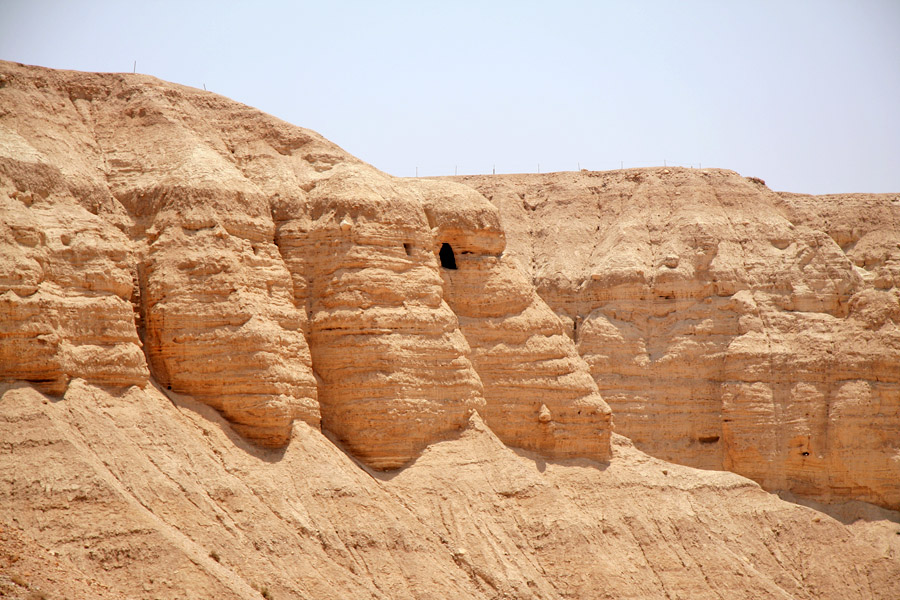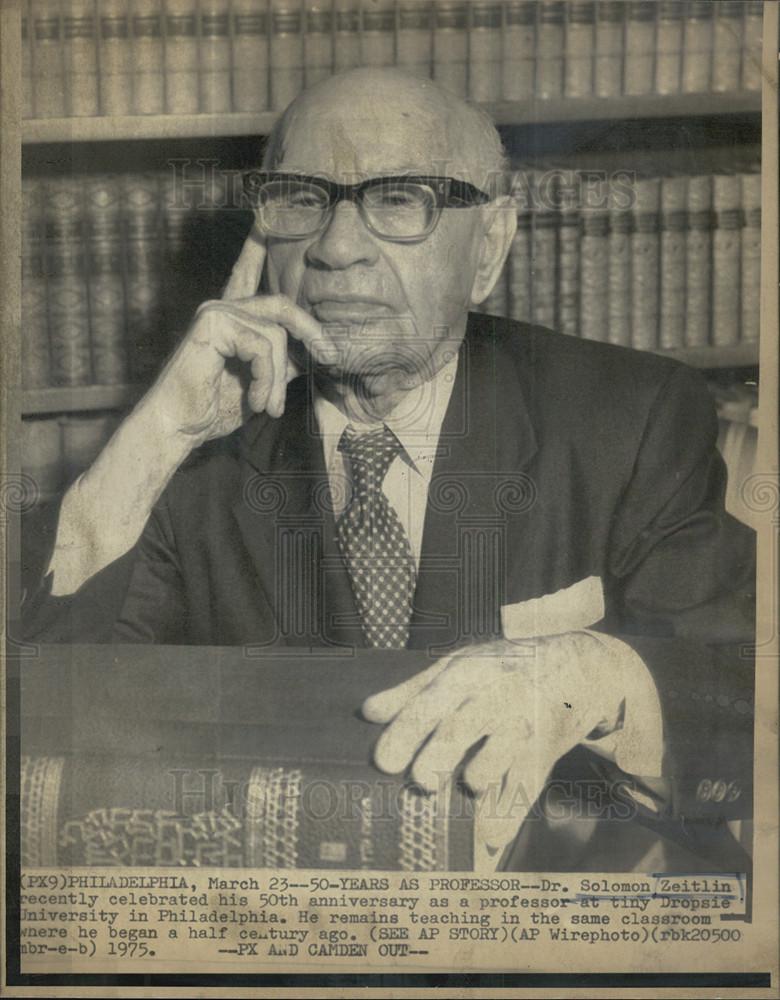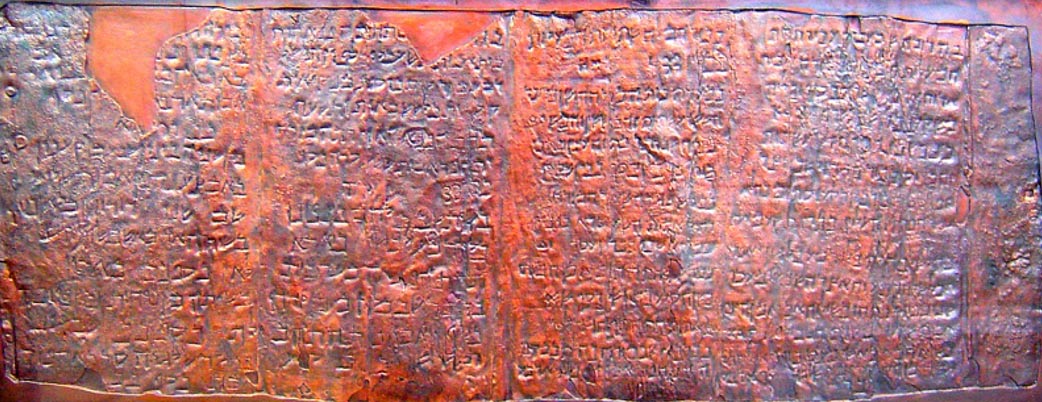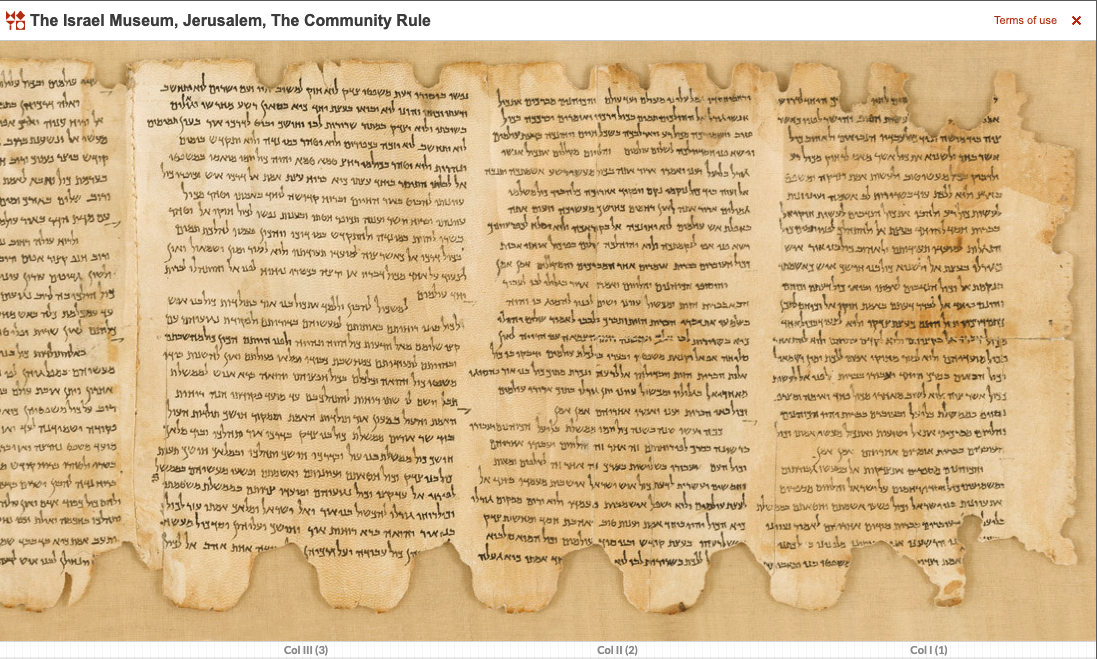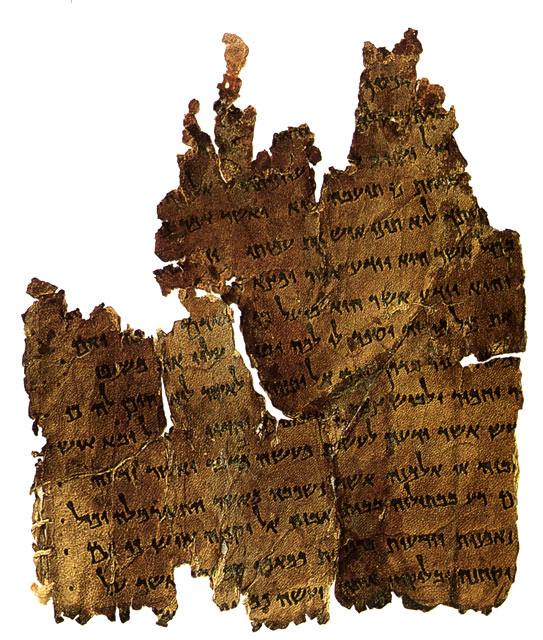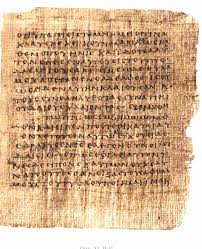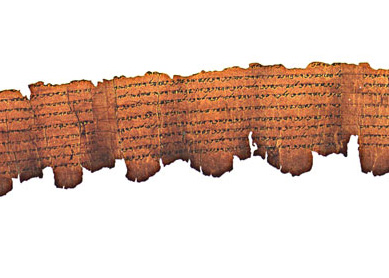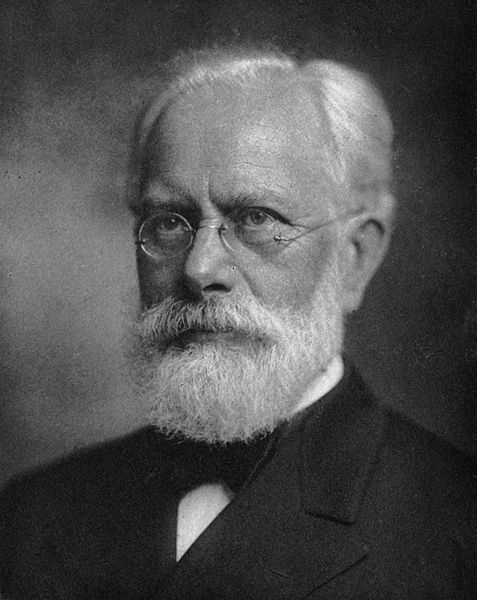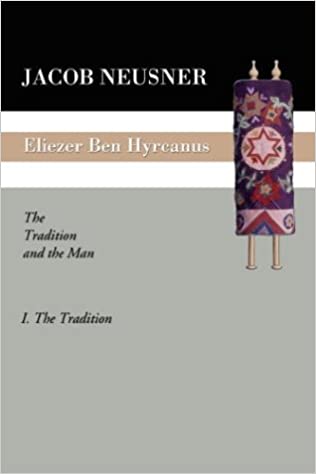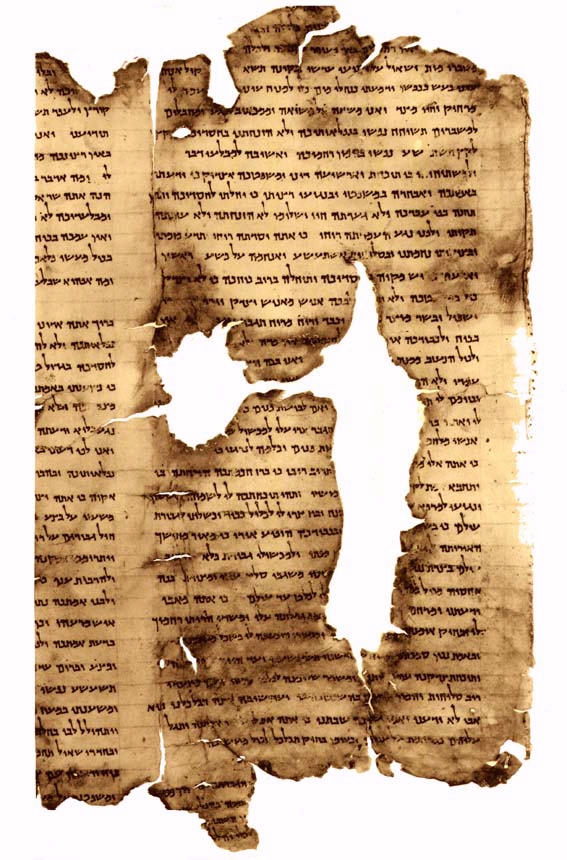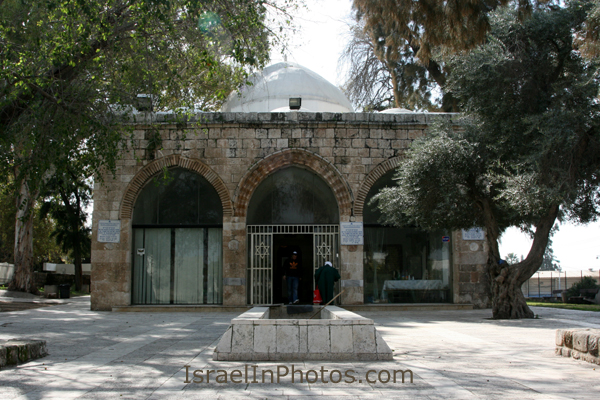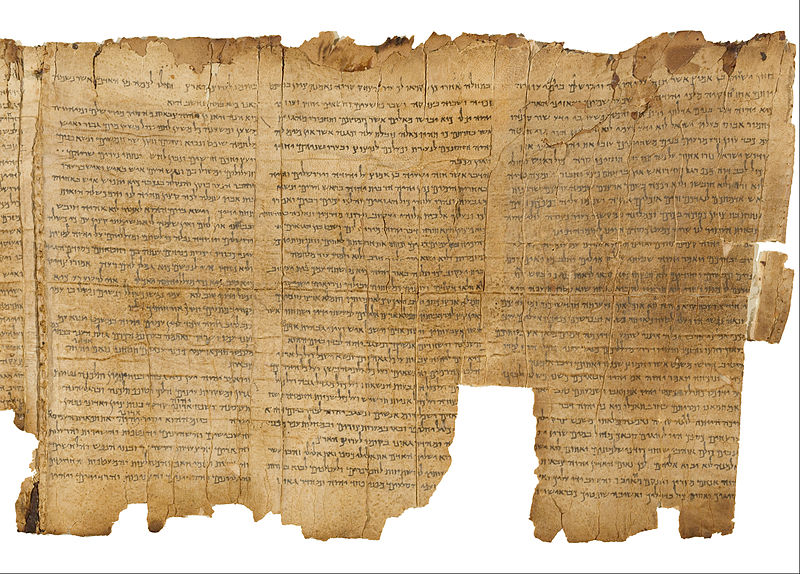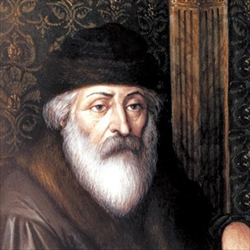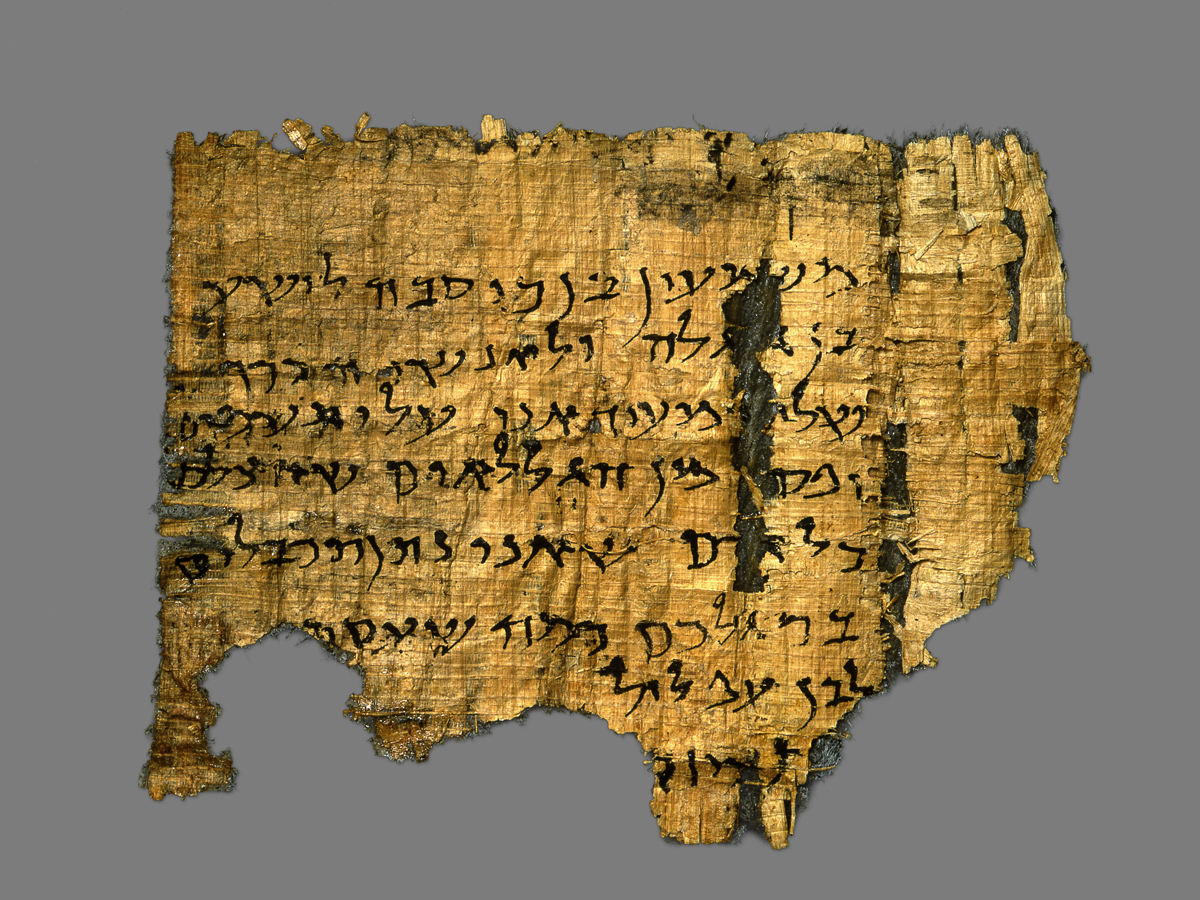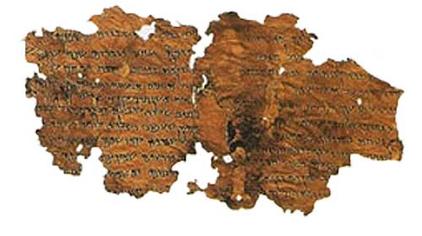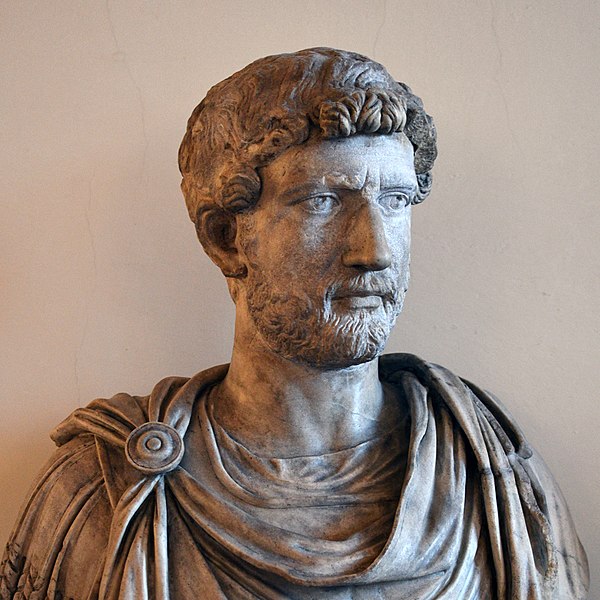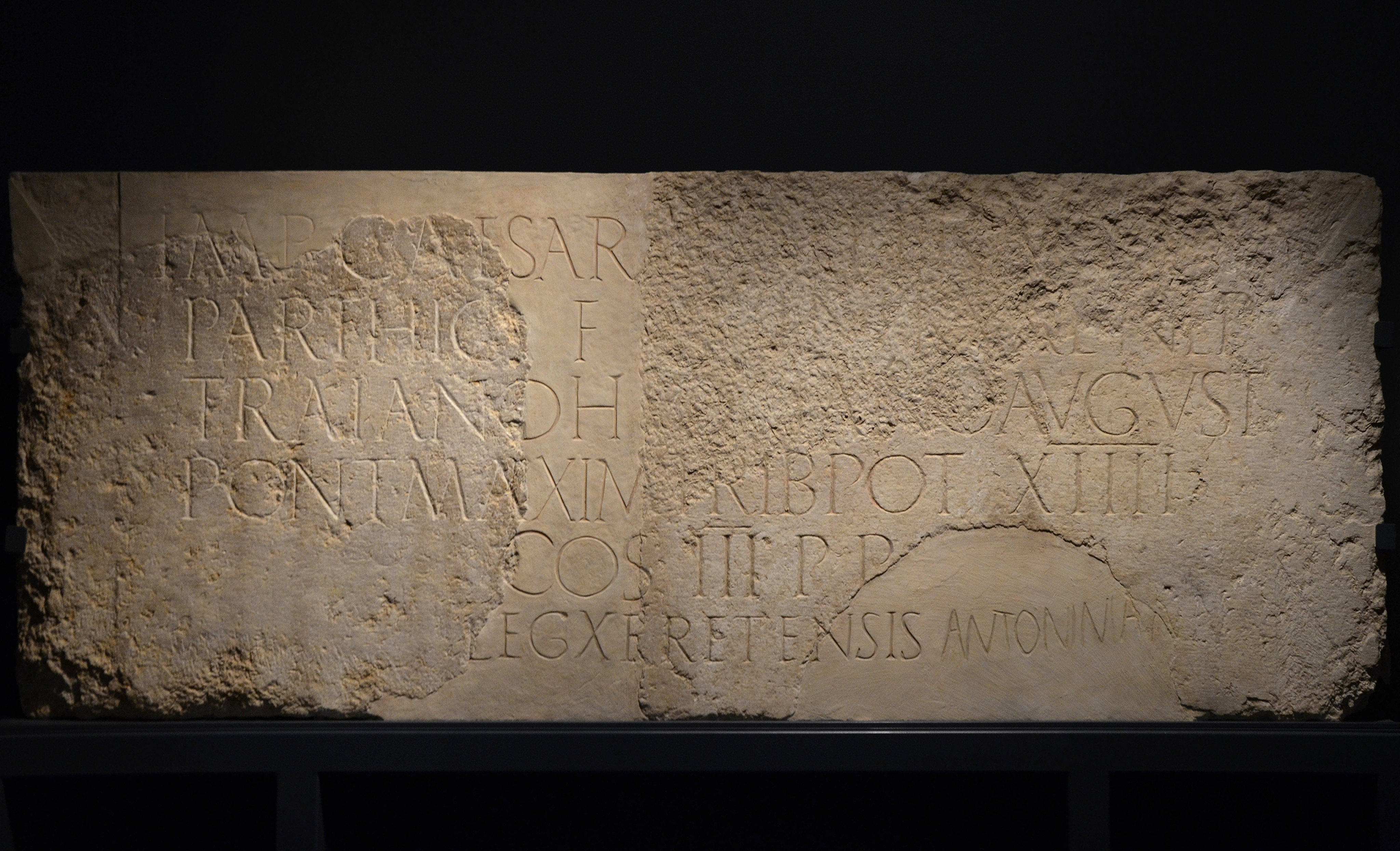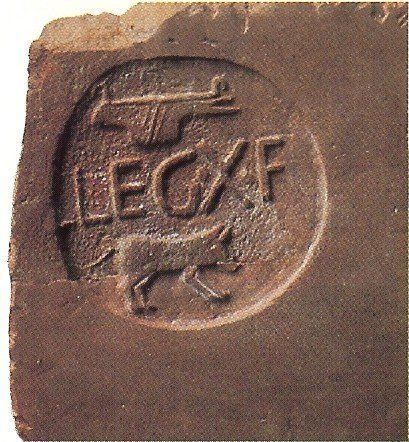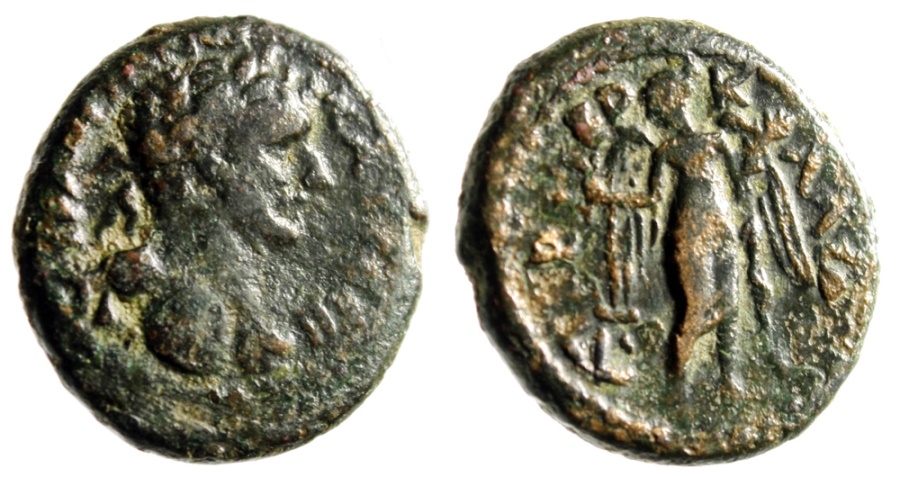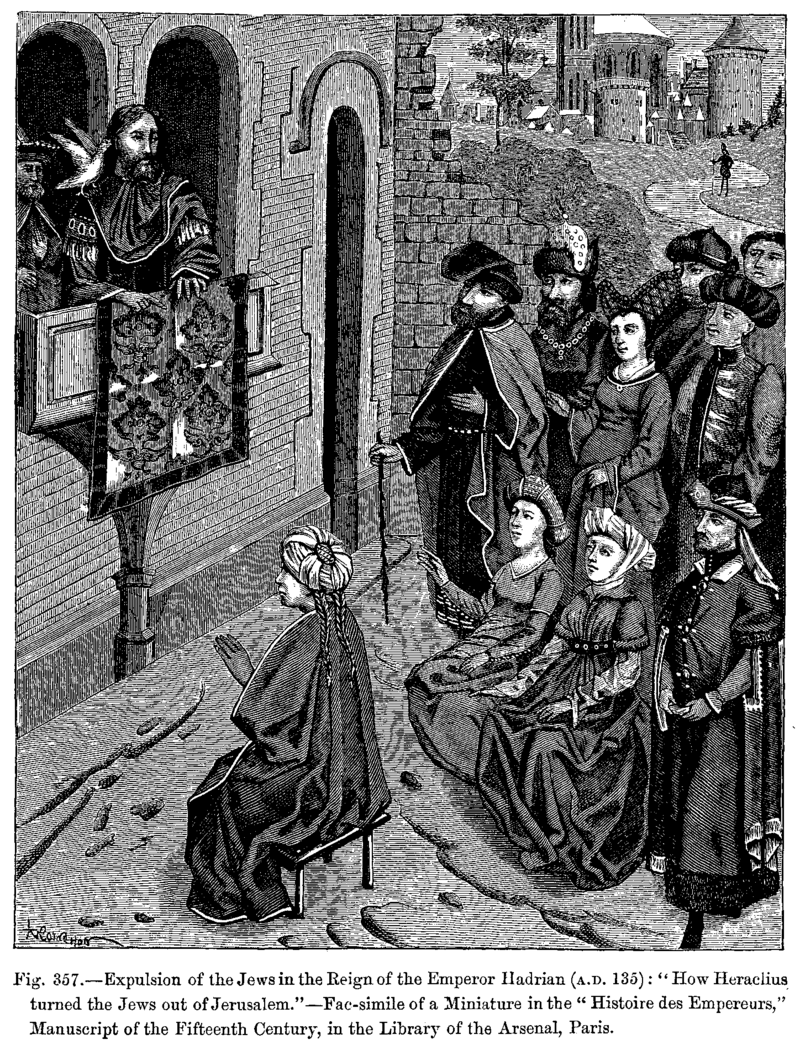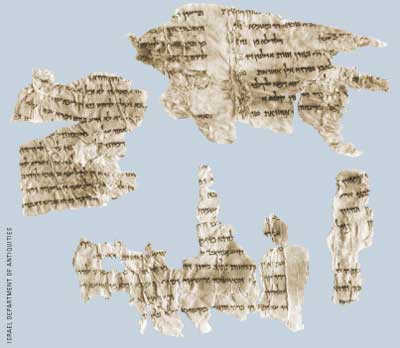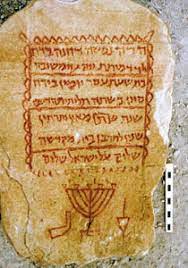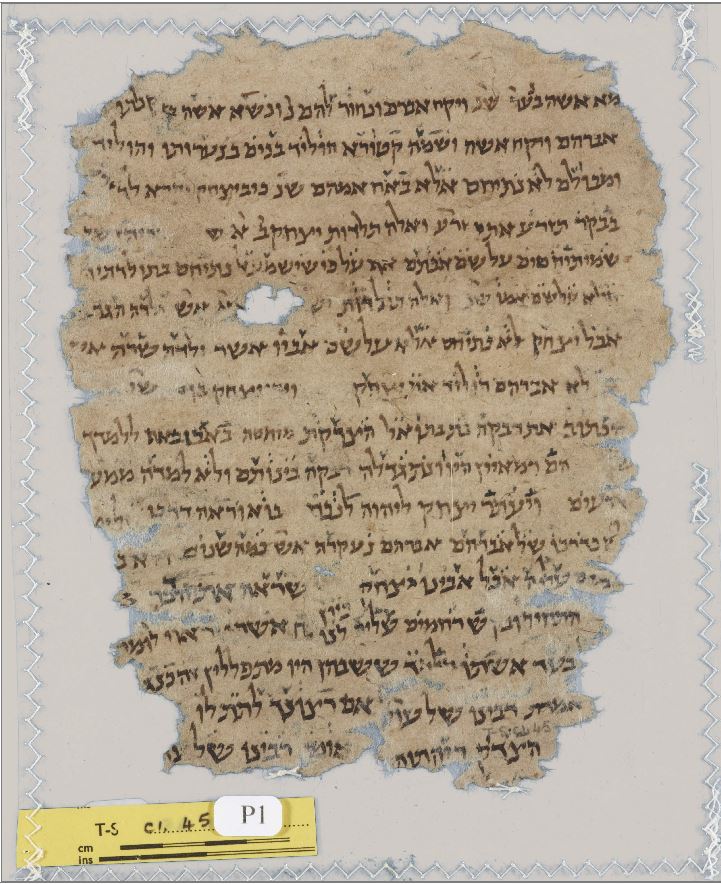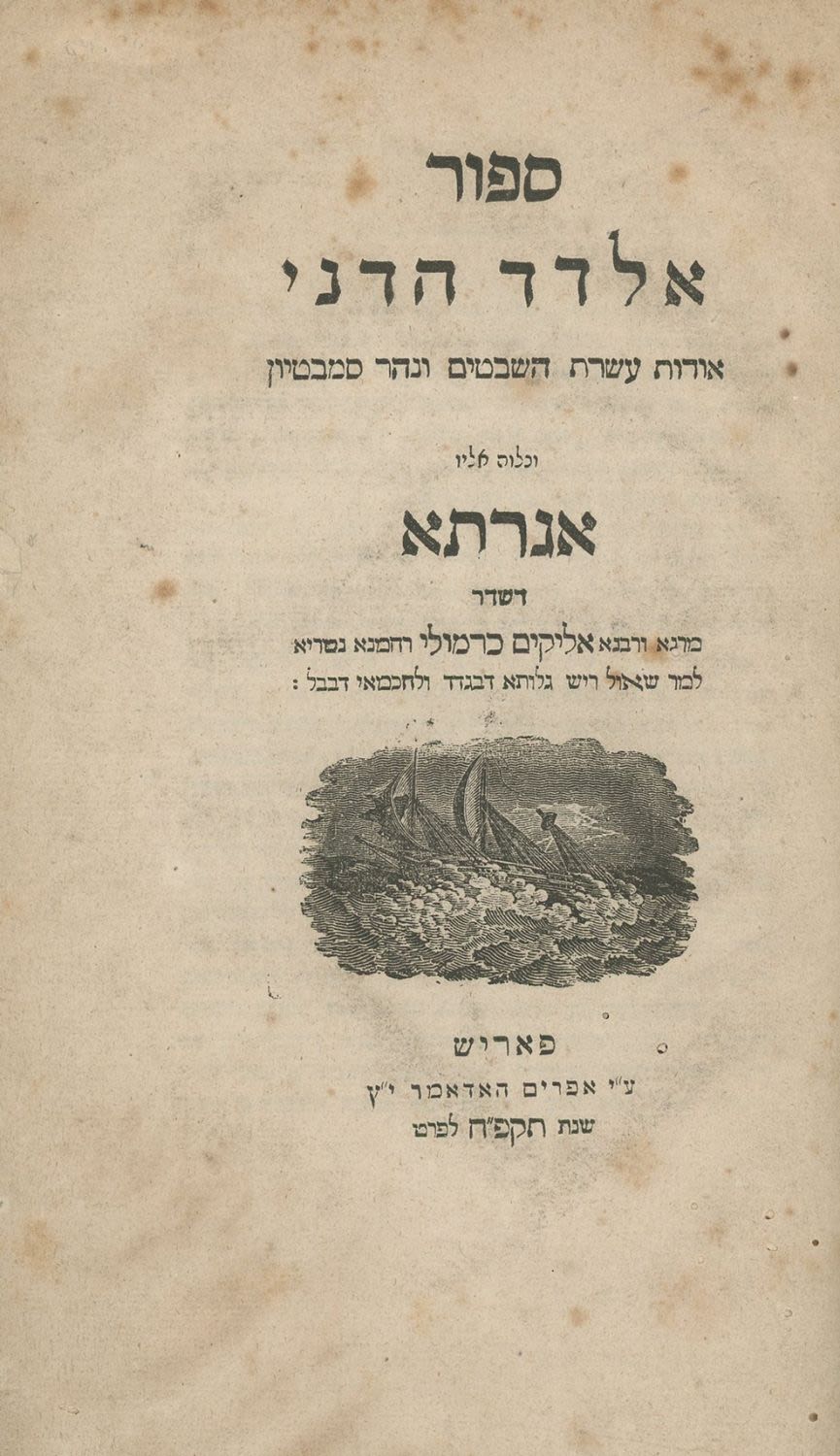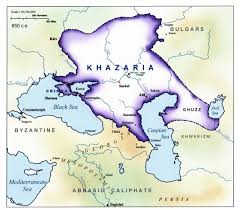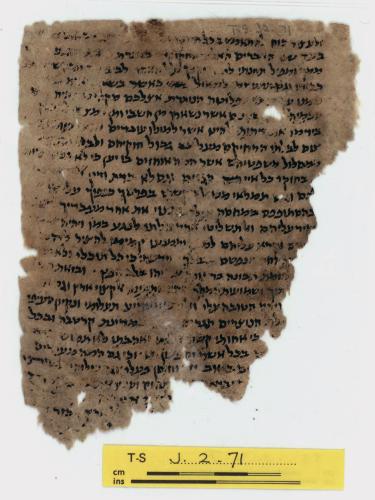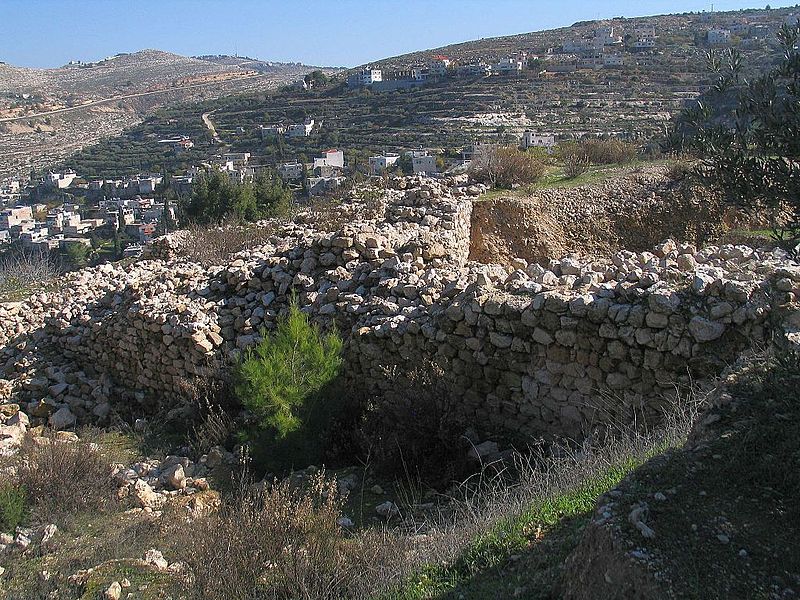1. Introduction
At the end of the 1940s and beginning of the 1950s, many ancient scrolls and parchment fragments were discovered in caves near the oasis of Qumran on the north-western shores of the Dead Sea. The authorship of these documents remains an unsolved mystery until this day, as does their chronology. This remarkable collection of documents includes not only the earliest known Biblical manuscripts written in Hebrew, but also many original and unique texts in Hebrew and Aramaic that are assumed to have been composed by the Jews who had hidden the Scrolls in the Caves of Qumran. In order to properly establish their historical value, and to determine when they were written and by whom, it is crucial to research the historical framework and the distinctive terminology that was used in these texts.
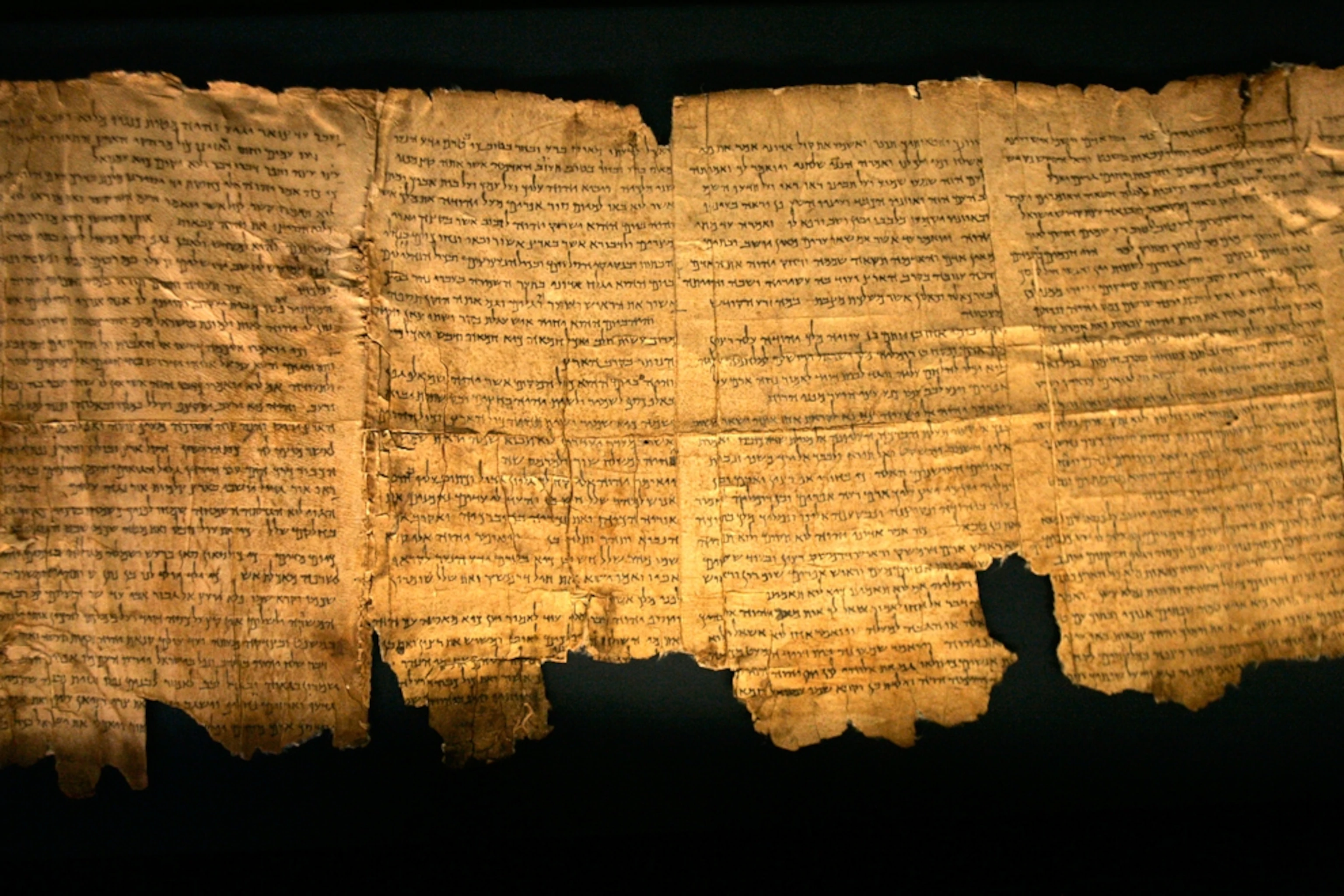
Israel Musesum. Photograph by Baz Ratner, Reuters
Dead Sea Scrolls
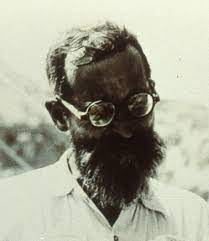
Public domain, via Wikimedia Commons
Roland de Vaux
The Dead Sea Scrolls were first examined in the early 1950s by a team of Dominican monks led by Father Roland de Vaux; they reached the conclusion that they had been written by the Essenes, a small group of Jewish sectarians, who according to Josephus Flavius and Pliny, settled in the area close to the Dead Sea in the 1st century BCE - 1st century CE, where they lived frugal and celibate lives. This would suggest that most of the Scrolls were composed during the Maccabean period, meaning that they were of pre-Christian origin and thus irrelevant to the story of Jesus, the Christian Messiah. At the time, this assessment gained wide acceptance, not only amongst Israeli scholars, but also within the wider academic world4. The Scrolls, therefore, continued to be viewed for a long time as authored by a small group of anti-establishment ascetics who had deliberately chosen to live in quiet seclusion in Qumran, far from the hostile priesthood of Jerusalem. Following their eventual publication, the Dead Sea Scrolls were re-evaluated and there was no longer a consensus with regard to their authorship. It was accepted that the halakhic ideas expressed in the Scrolls, especially in the Halakhic Letter81, did not fully match the views previously attributed to the Essenes, especially in respect of their idea of celibacy128. These rules were comparable, however, to those found in the Talmudic sources that the rabbis attributed to their adversaries, the sectarian Jews known as the Zadokim, who were regarded as descendants of the Sadducees - the enemies of the Pharisees, the spiritual ancestors of the rabbis. It should also be stressed that there is not a single mention of the Essenes in the Scrolls; instead, it appears that the sectarians regarded themselves as descended from the tribe of “Judah”, and their leaders the “Sons of Zadok, the priests”.
Lawrence Schiffman pointed towards a later self-identification of the sectarians and decided that the “Zadokite” identity, in fact, reflected their Sadducean origin. After examining the approach towards Halakha in the Scrolls – particularly with respect to the rules relating to matters of ritual purity – with the rules set out in the Talmud and ascribed to the Zadokim, he concluded that the Scrolls were composed by an “extreme branch” of Sadducean Jews. He identified them as the small group of aristocratic priests who had been in charge of the Second Temple; following the installment of the Maccabean High Priest in place of the Sadducean one, they had fled from Jerusalem to Khirbet Qumran and settled there on the eve of the Maccabean Revolt, around 152 BCE129. The problem with this approach, however, is that there is no evidence that the Sadduceans ever occupied the position of High Priest prior to 152 BCE. Additionally, there is no mention in any sources, including Josephus Flavius, of the Sadduceans existence prior to the time of John Hyrcanus (134-104 BCE). During the later period, however, and up until the hurban – the destruction of the Second Temple by the Romans in 70 CE, the Sadducean priests were responsible for maintaining the Temple services, and would have had no reason to leave Jerusalem, or to oppose the Temple’s cult.
While Norman Golb agreed with the “Sadducean” identity of the sectarians, he argued against the connection between the Caves of Qumran and Khirbet Qumran. The disparity in approach found in the Scrolls led him to conclude that they had originated in a number of different libraries in Jerusalem and had been removed and hidden in the Caves of Qumran after 70 CE. His analysis of the sectarian writings of Qumran, in particular, the Pesharim – the original commentaries that contemporized Biblical Prophetic events – suggests that these texts reflect the diversity amongst different rival groups during the time of the First Jewish Revolt51. In my opinion, and as will be shown below, Golb’s claim that the Scrolls were hidden soon after the hurban does not take into account that some of the events referred to in the Pesharim must be dated to the time of the Second Revolt.

University of Chicago Archive
Norman Golb
Robert Eisenman also argued against the results of the carbon-dating that placed the composition of the Scrolls in the Maccabean period, and his interpretation of their content as being militant and zealous led him to date them to the late-Herodian era, which would means that the priesthood that they opposed was, in fact, the collaborating Herodian priesthood. He provided parallels between the political, religious, and ethical stance of these documents with the views held by James, the brother of Jesus, whom he identifies as the founder of the sectarian movement of Qumran37. However, if the Scrolls were of early Christian origin, it is strange that the figure of Jesus, the Christian Messiah, is missing from them.
Solomon Zeitlin, who constantly argued against the Second Temple dating of the Scrolls, put forward a few arguments concerning the dating of the Pesharim. As an example, he noted that they show familiarity with an Aramaic translation of the Prophets, the so-called Targum Johathan, dated to the 2nd century CE. Another example is the inclusion of matres lectionis (consonant letters that are used to represent vowels), which occurs frequently in the Scrolls but only came into usage during the time of R. Akiva153. He later concluded that most of the Scrolls should be dated from the early medieval period and belonged to one of the Karaite groups, who regarded Shammai to be their main religious authority152. While I cannot accept such a dating, I would agree that the style of the Pesharim can be compared to that of the Midrashic method that appeared in the 2nd century63.
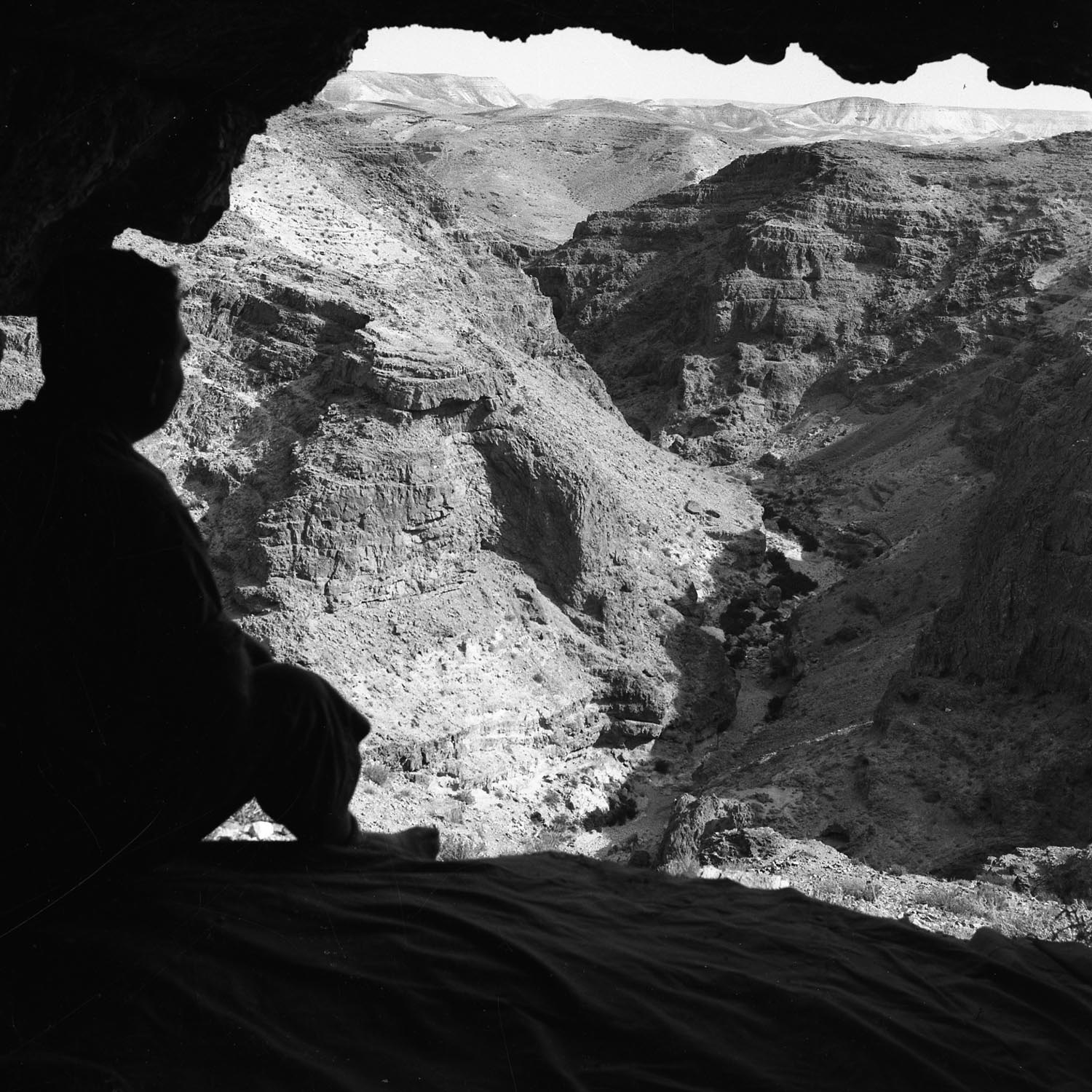
רשות העתיקות של ישראל Israel Antiquities Authority, CC BY-SA 4.0, via Wikimedia Commons
Cave of Letters
The first identification of the Scrolls as books from the Second Temple period was established on the basis of the similarities between the shapes of the letters they used and those appearing on the Jewish ossuaries with Aramaic inscription, discovered around Jerusalem. Importantly, no original Hebrew manuscripts that can be unquestionably dated to the Second Temple period were ever found; the documents from the Cave of Letters, as well as other finds, originating from Wadi Murabba’at, represent the earliest survived documents, written in the Hebrew language and script, and have been dated to the time of the Second Revolt62,149. Therefore, the paleographic arguments that the scholars attempted to substantiate while establishing the dating of the Scrolls within the Second Temple period, are irrelevant. Apart of that, some scholars have continued to rely on radio-carbon dating analysis of the Scrolls, which supposedly confirms their Hellenistic dating, however, various analyses demonstrate a very wide range of dating possibilities5. It is also interesting to note that many of the later calibrated dates, in fact, refer to the period after the hurban, with a wide range of dates lasting up until 118 CE, furthermore, some Scrolls, for example, the Covenant, could be dated up until 129. It seems important that the Cave of Letters, and the Caves of Qumran, were shown to be typologically similar in construction to other caves that were known to have been used by other groups of the supporters of the Bar Kokhba Revolt, for hiding from the Romans and also for keeping their precious valuables in140. The Copper Scroll described in details the whereabouts of valuables that had been accumulated by the rebels and then hidden in various locations in times of danger. The language of this Scroll is different from the rest of the sectarian documents, and it might be inferred that it was composed by the supporters of Bar Kokhba, who, after the suppression of the Revolt, decided to join the sect of Qumran.
2. Who were the Zadokite Jews?
Study of the Scrolls has shown that the religious beliefs followed by the sectarians differed from what we know of the ideas of the rabbis of Yavneh that were based on the traditions of the “House of Hillel” from the Second Temple period; at the same time their approach to the principles of Halakha was similar to that of their rivals, the “House of Shammai”. This inevitably raises the question as to which identity was maintained by the community that was responsible for producing the Scrolls. As both the Community Rule7,147 and the Damascus Covenant9,34,64, two highly significant sectarian documents of Qumran, refer to the founding members of the movement as the “Sons of Zadok, the Priests” (CD IV, 1,3; CR V, 1, 9; IX, 14), these two distinct treatises evidently relate to two very different stages in the chain of development of the rules of Halakha practiced by the Zadokite Jews.
The Community Rule (Serekh Ha-Yahad), also known as the Manuel of Discipline, appears to contain thoughtfully selected instructions that were drawn up to provide a regulatory framework for the life of a priestly community of the “Sons of Light”; it seems to reflect the earliest phase in the development of the sectarians’ ideas. The mention of the “priests” next to the “Sons of Zadok” suggests that their leadership mainly consisted of priests from the former Temple who, when they found themselves in exile, decided to establish the ascetic community of Yahad. Here they lived a rigorous lifestyle, denying themselves a family and abstaining from wine. In sharp contrast, the vibrant messianic community of the Covenanters had no wish to continue to impose such restrictions upon themselves any longer; they believed that although their ancestors had left the Land of Judah and fled to the Land of Damascus, they would return to their homeland in the “End of Days”64. The Covenanters also believed that their movement had been founded by a person named Zadok (CD V, 5), their eponymous founder, to whom all the “mysteries” of the world were made known and who had miraculously obtained these teachings from a “Sealed Book of the Law” (CD V, 2) that had been placed in the Ark of the Covenant before the time of King David. As the priest named Zadok was known as the High Priest of the Solomonic Temple, it was suggested that the founders of the sectarian movement were Sadducean priests who were his spiritual descendants and had served as priests in the Second Temple145. However, this theory has to be discounted as the Covenant explains that King David had multiple wives meaning that the “Sealed Book of the Torah”, which forbade polygamy, had not been revealed to him; it follows that it was only later, after this book was known to Zadok, the sectarians became aware of these laws (CD V,16).
Another possibility to consider is that Zadok was a historical figure from the end of the Second Temple period responsible for creating the anti-rabbinic tradition. The Karaite scholar, al-Qirqisani, who probably relied on a rabbinical work of the Geonic Era, Avot de-Rabbi Nathan, decided that the resistance to the rabbis started when Zadok and Boethus, the disciples of R. Antigonus, were “led astray”. He further attributed to Zadok the invention of a 364-day calendar and the concept of establishing holidays on certain days of the weeks instead of the months25. Additionally, he reported that Zadok, while criticizing the rabbis in his book, promoted the idea that a man should be prohibited from marrying his niece. It has been suggested that when al-Qirqisani claimed that he had the Book of Zadok in his possession, he might have, actually, been referring to a copy of the Covenant43, where similar ideas appeared and where the figure of Zadok was prominently highlighted; this might have led him to believe that it had been authored by Zadok. In addition, al-Qirqisani also mentioned “Maghariyya” (the “cave people”), who came after Zadok and owed their name to the fact that their books were discovered in a cave; these people have been identified as the sect of Qumran.
The Babylonian Talmud described the primary opponents of the rabbis during the Late-Antique period as the “Zadokim”, also referred to as “minim” (heretics) (Hag. 2, 4-5, Men. 10, 3). When examining various evidence from the Talmud relating to the controversies between the rabbis and the Zadokites, Richard Kalmin noted that the negative references to their opponents were probably not based on the old religious differences between the Pharisees and the Sadducees, but instead were meant to highlight the sectarian group that presented a serious alternative to the rabbis in the Late-Antique period75. Based on the differences between the rabbis and the Zadokites, Igor Tantlevskij showed that the Sadducees of the Second Temple cannot be equated with the “Zadokim” in the Talmud – firstly, because of their disagreement with the rabbis concerning the calendar, and secondly, on account of the dualistic character of their views. In his opinion, it would have been difficult to uphold these inconsistencies in the Second Temple, since the Sadducean priests, who were responsible for performing the sacrifices, would have been required to adjust the calendar in respect of the dates of the holidays139. This can be explained, however, if it is accepted that the traditionalists of Qumran used the priestly 364-day calendar advocated by 1 Enoch. In the same way that it is conceivable that the Pharisees of the Second Temple evolved into the rabbis, it is possible that the Sadducees also did not disappear, but instead the priests who left Jerusalem for Damascus evolved into the Zadokim; the cataclysm they suffered changed their attitude towards the strict monotheism and halakha.
The fact that the “Land of Damascus” was central to the early history of the Covenanters would seem to confirm the Syrian roots of the movement. According to John Reeves, there is a possibility that the Zadokite tradition flourished among the Syrian and Upper Mesopotamian Jews during the Late Antique period, which could explain why the Syriac literature appears to be especially rich in Pseudo-epigraphical ''survivals''117. In this regard, he cited a passage found in the Syriac text Vita Rabbula, a hagiographic work on Rabbula (411-35 CE), the Eastern Church leader responsible for the establishment of orthodoxy in the city of Edessa. In this text, its author identified a number of heresies that Rabbula suppressed upon his arrival in the city, including the mention of Zadokim alongside the Audians, a Gnostic dualistic group. In Reeves’ opinion, this was not accidental, and probably reflected the Christian attitude towards the Zadokim as Gnostics, which can be compared to the identity of the Manichean priests as “Righteous”116. It is interesting to note that the attitude of the rabbis towards the Manicheans was remarkably similar to that shown towards the Zadokim; Moshe Gil showed that the origin of the Talmudic term hanefim (“hypocrites”) used to describe the minim, is in fact relates to the Syriac term hanpe that was used to denote the Manicheans48.
Since the Talmud accused the Zadokim of being followers of dualistic views (Hul. 87a) and of “believing in the two powers in the sky” (Sanh. 38a), Kohler argued that these views were, from the rabbis’ perspective, similar to those of other dualistic groups (Ber. 58c; Shab. 88c; Ned. 49b), which is why they treated their writings, sifrei minim, in the same way as the Gnostic books (Sanh. 10a; 100b)80. The rabbis probably referred to the Zadokim as “Jewish Gnostics” on account of their dualistic views that were related to the concept of the Hidden Knowledge that was, apparently, disclosed to them, and the idea of the constant conflict between the Sons of Light and the Sons of Darkness as revealed in the Community Rule and the War Scroll. Although numerous attempts were made to explain this phenomenon being a result of Zoroastrian influence, it is worth noting that access to the Hidden Knowledge was a common claim amongst many Gnostic groups132. Since certain examples of the literature related to the Scrolls was preserved in the 4th century Gnostic library discovered in Nag-Hammadi, in Upper Egypt, it is probable that the Gnostics recognized the sect of Qumran as one of their own58. One text relates to the figure of the Priest Melchizedek, and refers to him as the Head of the Angels, who according to 11Q Melch, will “execute divine judgment” in the future eschatological Jubilee year88; another – an important Gnostic book named Three Steles of Seth contained the text entitled the Revelation to Dositheus.
The historicity of the figure of Zadok, the eponymic founder of the sectarians’ movement, can be further reaffirmed if he is identified as Prophet Dositheus. According to the statements of Pseudo-Tertullian and Eusebius, he had been the founder of the sectarians known as the “Sadducees”, although it is probable that by these the Christian writers of the 4th century were actually referring to the Zadokim. The idea of identifying Dositheus as Zadok had already been proposed by Solomon Schechter; he had accessed two copies of the Damascus Covenant dated to the 10th - 11th centuries that had been discovered amongst the medieval Hebrew documents in the Cairo Genizah; and, in 1910, had published them as the Zadokite Fragments127. The 12th-century scholar, al-Shahrastani, reported that the Dositheans regarded their founder – who lived a century before Christ – as Ilfan (Teacher in Aramaic). Based on this chronological indication as well as evidence from the medieval Samaritan chronicle of Abu'l-Fath, who placed Dositheus in the time of John Hyrcanus, Schechter suggested that he might be considered a historical figure from c. 100 BCE. Abu'l-Fath relates that Dositheus was a Jew from Jerusalem, who, after his rejection at the hands of the rabbis, went to preach in Samaria; he was thrown out of Shechem by the local leaders, and spent his last days in exile writing his books in the house of a widow in a village of Suwaika.
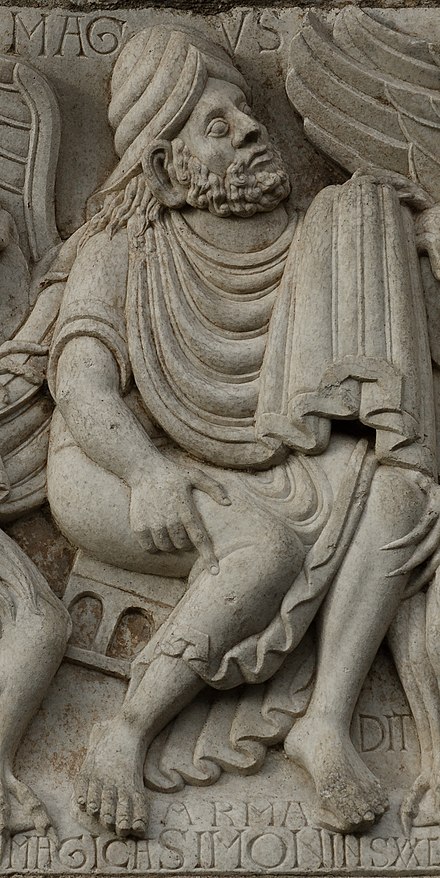
PierreSelim, CC0, via Wikimedia Commons
Relief of Simon Magus at the gate of the Basilica of Saint-Sernin, Toulouse
In 1976, Stanley Isser issued his most comprehensive study of the Dositheans sect, where he argued in favor of a later, mid to late-1st century CE date for Dositheus70. He mainly relied on the dating provided by the Clementine Romance that was written in the 4th century by the Christians against the Gnostics. This dates the activities of Dositheus to the same time as those of Shimon Magus – a historical figure from the 40s CE, who opposed the Apostles (Acts 8:9-24), and was also often referred to as “the father of all heresies”. The Romance includes a story of a competition that arose between the two heresiarchs and tells how Dositheus, by spreading a false report of Shimon’s death, succeeded in installing himself as head of the sect. Upon his return, Shimon thought it better to dissemble, and pretending friendship for Dositheus, accepted second place148. The importance of this story lies not only in the fact that it provides evidence of Dositheus’ success in spreading his teachings among the Gnostics, but it also indicated a dating for his activities. It seems that the idea of the Gnostic influence in the Scrolls120,123 clearly contradicts their Hellenistic date since the dualistic views only became popular in Judea after Shimon Magus, unless, of course, we would like to claim that the Scrolls somehow preserved a “Jewish Gnosticism” before the rise of Gnosticism.
This chronology for the beginning of the sectarian movement can be confirmed by analysis of the chronological information recorded in the Damascus Covenant. The Admonition, a series of historical introductions to the Covenant, provides a valuable indication as to when the movement first came into being (CD I, 3-11). It dates its origins in the “period of wrath”, when “God hid his face from Israel and from his Sanctuary…three hundred and ninety years after they were delivered into the hands of Nebuchadnezzar, king of Babylon”, he, however, “caused to sprout from Israel and from Aaron a shoot of the planting”, and twenty years later, “after they walked like blind” – the Teacher of Righteousness, finally, “rose up to lead them in the way of his heart”. In determining the chronology, the mention of 390 years has confused many scholars who have attempted to link this evidence with the exile in 586 BCE that had been ordered by Nebuchadnezzar II, thereby placing the roots of the Covenanters before the Maccabean revolt. One possible solution to this problem was suggested by Zeitlin, who pointed out that the chronology that was used by the rabbis was different from the modern one. According to the Seder Olam Rabbah, ch. 30, the Second Temple stood for 420 years, while the time between the fall of the First Temple and the building of the Second Temple was 70 years. Accordingly, Zeitlin arrived at the conclusion that the arrival of the Teacher of Righteousness should be dated c. 30 BCE, and that the dating of the conflict within the Jewish leadership could, therefore, be related to the time of the fight between the two important early halakhic authorities, Hillel and Shammai152.
In my opinion, a solution can be found if the reference to the actions of “Nebuchadnezzar”, in fact, relates to the plundering of Judea, which was carried out in the 340s BCE by the Achaemenid King, Artaxerxes III Ochus, whose identification was revealed through analysis of the Book of Judith; this describes the conquest of Judea by Nebuchadnezzar’s generals, Holofernes, and Bagoses. These characters have been identified as Orophernes, the Cappadocian satrap of Artaxerxes III, and his eunuch and general, Bagoas97. Additionally, Dan Barag’s analysis of archaeological evidence from Judea indicated a significant decline in the development of sites in the 340s BCE, thereby supporting this interpretation8. Applying the period of 390 years would bring the origin of the sect to the 50s CE; however, if the sectarian chronology differed from the modern scientific one, the Covenant’s reference that the “sprout from Israel” arose during the “period of wrath” would imply that the movement was established after 70 CE, and that the period of twenty years, when the sectarians “walked like blind” most probably referred to the turbulent period until the arrival of the Teacher of Righteousness.
The last part of the Covenant provides a key chronological indication as to the date of its final composition. It implied that there was a period of about forty years between the “gathering” of yoreh y-h-d, and the time when “all the Men of War who turned away with the Man of Lies (ish ha-kazzav) disappeared” (CD XX, 14-15) . In my opinion, the term *yoreh yahad, as it appears in the Covenant, was not an error of the copyist, but rather was intentionally used by the last editor of the Covenant, to distinguish this figure from more zedek, the Teacher of Righteousness. Taking into account that the indication of a Biblical period of “forty years” usually refers to the timeframe set for one generation, it can be concluded that the person known as yoreh yahad, who was identified as *more yahid – the “Unique Teacher” – or, more precisely, the “Teacher (of the Community) of Yahad”, is not identical to the Teacher of Righteousness. The Pesharim revealed that this latter figure was a contemporary of ish ha-kazzav – the Man of Lies, who is identified as Bar Kokhba, in line with the proposal firstly put forward in 1912 by Gresmann and Lagrange82. Thus, the Covenant related to a period of forty years between the death of the Teacher of Yahad, in 95 CE and the end of the Bar Kokhba Revolt, in 135 CE.
I believe that the identity of the sectarian leader known as * yoreh yahad can be discerned from information preserved by Abu'l-Fath, who recorded that Dositheus’s ideas were widely disseminated thanks to the efforts of his assistant, Yahdu. He came from the Samaritan village of Askar and was prominently regarded by Abu'l-Fath as a “very learned man, who was unique in his time in knowledge and in law”; he was an ascetic who did not drink wine and was very impressed by Dositheus’s explanation forbidding the eating of the firstborn of animals19. I would like to suggest that his personal name was probably recorded in the original title of the Community Rule – Serekh Ha-Yahad, where the ascetic ideas and teachings akin to those applied to Yahdu by Abu'l-Fath, revealed. It is possible that Yahdu was responsible for the Samaritan influence in the Scrolls that has become increasingly evident through recent research; indeed, scholars have realized the significant impact the Samaritans had on the formation of the sectarians’ library76. For example, Emmanuel Tov’s comprehensive study of the text of the Torah Scrolls of Qumran convincingly shows that, while not quite identical, they closely resembled the Samaritan rather than the Masoretic version of the Torah’s text142. The inclusion of the Tetragrammaton written in the Paleo-Hebrew (Samaritan) script, in the Pesharim, and the Psalms, is particularly notable; additionally, the Leviticus Scroll was entirely written in the same script61. It must be remembered, however, that this script which had been entirely forgotten during the Herodian period returned to usage during the Second Revolt.
The theory that the Covenanters should be identified as the Samaritan Dositheans was initially developed by Kohler79. He noticed that, although Dositheus, himself, was a Jewish religious leader of the Second Temple period, the importance of his figure during the Late Antique and medieval periods was primarily attached to the history of Samaritan sectarianism, and that the beliefs and traditions attributed to the Dositheans corresponded closely to what is known of the Covenanters . They anticipated the resurrection of their former leader and believed that he would reappear soon as the Messiah, son of Aaron and Israel (CD XIX, 10-11; XX, 1). According to Kohler, this priestly messianic concept was directly influenced by the idea of the old Samaritan priesthood descending from Aaron, and contradicted the rabbis’ concept that the Messiah would be descended from King David. After having studied the communal structure of the Covenanters and their various laws concerning Halakha, Kohler concluded that they were remarkably similar to those practiced by the Samaritan sectarians. The Zadokite identity of the sect of Qumran during the final period of its existence is reinforced by evidence from the medieval Samaritan chronicles. Abu'l-Fath related that among the followers of Dositheus was a group of “Sadukai”, who were referred to as “Zadduqim” in the Adler Chronicle; it was reported that “for seven years they practiced in a village named Maluf (“the place of teaching”) until the place fell upon them”19. Since no place with this name is known in Samaria, it is possible that it was a reference to Khirbet Qumran.
After the discovery of the Scrolls, John Bowman concluded that the 364-day solar calendar of Qumran was identical to the ancient Samaritan priestly calendar; he compared this to the fact that the Dositheans also used a solar calendar and counted 30 days each month18. He looked at the sacrificial rites of the Covenanters and noted a similarity in respect of the sacrifice of a red heifer that was described in the Song of the Sabbath Sacrific; he also noted that both groups demanded purification through water and constant bathing, and like the Samaritan Dositheans, the Covenanters had a requirement that anyone coming near a dead body must bathe before touching anything. All of this led Bowman to suggest that the strict requirements for ritual purity ensured that the sacrificial practices, which were forbidden in Jerusalem and on the Gerizim Mount, were permitted by the sectarians in Qumran. I believe, however, that these notable similarities between the practices of the Samaritan Dositheans and the Zadokites of Qumran should be considered as evidence of their possible common Dosithean origin, rather than proof that they should be identified with one another. It should also be noted that the Samaritans reported that there were various groups of followers of Dositheus60.
3. Eliezer b. Hyrcanus as the Teacher of Righteousness/ Interpreter of Law
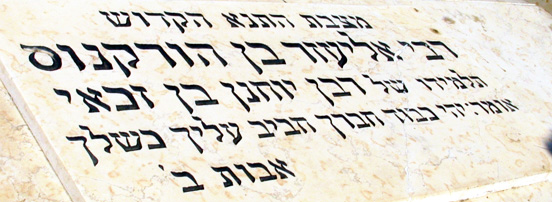
Public Domain
Eliezer b. Hyrcanus - Epitaph in Tiberias
The transformation of the Dositheans Community of Yahad into the Damascus Covenanters occurred following the great influence exerted by the person known as the “Teacher of Righteousness”, who appears to be the most significant figure in their history. This figure was unknown in the Community Rule, which was probably written sometime before his arrival in the sectarian community, but, a part of the Teacher, the Covenant also refers to the “Interpreter of the Law“ (doresh ha-torah), who “came to the captivity of Israel in the Land of Damascus and proclaimed the New Covenant” (CD VI, 5-8; VII, 18-19). An additional information on the figure of the “Teacher of Righteousness“ – otherwise named melits daat – “Interpreter of the Knowledge“, in the Pesharim, which using language that codified, but which may certainly have been understood by contemporary readers. For many years, scholars have argued over how to de-code the sobriquets of the Scrolls, while also trying to fix these hidden identities within the historical context of the Second Temple period and, indeed, there is still no consensus in respect to any of the endless proposals29. The identity of the leader of the sectarians, more zedek – the “Teacher of Righteousness“, is amongst the most debatable subjects in the current research of the Scrolls; as is his alter-ego, kohen ha-rasha – the “Wicked Priest“. Additionally, the identities of his opponents, a religious leader named mettif ha-kazzav – the “Preacher of Lies”, and a political and military leader, named ish ha-kazzav – the “Man of Lies” – have yet to be resolved. Controversy also surrounds the identification of the foreign invaders, the “Kittim”, or the “Kittim of Ashur”, as well as their powerful leader – the “Man of Belial”.
In my opinion, the sobriquets used in the Pesharim do not fit into the available database of the Hasmonean period, - not least because it is proving impossible to find a single timeframe that works for all of them. For example, in his book, "The Dead Sea Scrolls and the Hasmonaean State", Hanan Eshel identified the Teacher with Jonathan the Maccabee (161-43 BCE); the Wicked Priest with John Hyrcanus (134-04 BCE); and the Kittim – with the Romans, who invaded Judea in 63 BCE45. However, these attributions completely ignore the question of how all these different characters could have been present in Judea at the same time. In my opinion, these contradictions can be successfully resolved if we accept that the Pesharim should be regarded as a primary source for understanding the attitudes of the sectarians towards political events happening during the Yavneh period, from the Great Diaspora Revolt until the end of the Second Revolt.
I believe that in order to identify the enigmatic figure of the founder of the Covenanters it is necessary to look for relevant information in Talmudic sources. I would like to propose that this sobriquet, in fact, refers to R. Eliezer b. Hyrcanus, one of the great lawmakers of the period, and a disciple of R. Yohanan b. Zakkai, the first leader of the Jews during the period after the hurban. At first, R. Eliezer b. Hyrcanus was a respected member of the main Jewish religious authority, Sanhedrin of Yavneh, that was headed by R. Gamliel II, his brother-in-law49,103. He established his own academy at Lydda108, where he gained a reputation as a great scholar of law, with many important Jewish scholars, including R. Akiva, associating themselves with his school. He famously opposed the approach of Hillel and agreed with Shammai on the interpretation of the Halakhic laws and strongly objected to R. Akiva’s creative idea on their paraphrastic interpretation of the Midrashic works being presented as ultimate authority on religious practice. It appears that R. Eliezer was especially concerned about the issues related to ritual purity, and it is said that the last word he uttered was tahor(pure) (Sanh. 68a). He finally broke away from the Sanhedrin of Yavneh, on the issue of ritual purity related in the famous Talmudic story of the Oven of Akhnai (B. M. 59a-b). His refusal to submit to the decision of the rabbis, apparently, led to his expulsion from the Sanhedrin of Yavneh and excommunication from the Jewish community of Judea by the decision of Sanhedrin issued by R. Gamliel and reported to him by his pupil, R. Akiva6. Despite this, the Talmud continued to refer to R. Eliezer b. Hyrcanus’s enormous contribution in the formulation of Jewish law, and he was referred to as Eliezer ha-Gadol (“Eliezer the Great”), or simply R. Eliezer.
It was convincingly shown by Vered Noam that the views expressed in 4QMMT and the Temple Scroll, especially those regarding ritual purity146 are practically identical to those associated with R. Eliezer b. Hyrcanus in the Mishnah106. Furthermore, she decided that this phenomenon could be interpreted as the old cultural legacy of Qumran that later found its expression in the rulings of Halakha by the school of Shammai107, 108. It seems, however, that such an interpretation is difficult to justify, since there is no historical background behind the ideological influence that could cause an impact from the small sectarian group which supposedly remained in the quite seclusion of Qumran during the late-Hellenistic times on the major school of halakha which was developed in Jerusalem during the period of the 1st century CE. In my opinion, the rulings attributed to R. Eliezer in the Mishnah were original concepts that followed the general approach of the school of Shammai and that were initially set by this important Zadokite leader.
Some fragmentary remarks in the Talmud relate to the fate of R. Eliezer after his excommunication. It is reported that he was arrested by the Roman authorities on charges of heresy and put in prison; however, he was found innocent and released by a court decision131. The Talmud recounts, in detail, the story of how R. Eliezer, when appearing before the court, proclaimed “Blessed is the True Judge”; in fact, he was referring to God but the Roman judge, thinking that he was referring to himself, ordered him to be released (Hul. 2:24; A. Z. 16b-17a). Interestingly, when it was reported that he had been arrested by the Roman authorities on charges of minut - “heresy”, it was suggested by R. Akiva that this was due to his interactions with Yaakov, the “disciple of Joshua” (Hul. 2:24). It seems that these accusations were not far from the truth since the Covenant which reflected R. Eliezer’s ideas, revealed its author’s familiarity with Christian ideas, particularly the concept of the “New Covenant”. In fact, it seems unlikely that R. Eliezer sympathized with the Christians, and, more probably, he was charged because he was well acquainted with the books of Enoch, which were accepted as part of the Scripture by the Christians, but considered heretical by the majority of the rabbis.
The Thanksgiving Hymns of Qumran that were probably authored by R. Eliezer, confirms the authenticity of the Talmudic story of his arrest and recounts the period of his persecutions by the “men of Belial” (the Romans); he also complained that the false accusations provided to them led to him being arrested and imprisoned (1QH 13:5-39); other Hymns, however, praise God for his safekeeping, suggesting that he was later released from prison. It is probable that, after being excommunicated, R. Eliezer found refuge among the Dosithean community of Jewish exiles in Damascus where, through his efforts, they were introduced to the principles of halakha issued by the school of Shammai as well as to the innovative concept of the “New Covenant”. It would therefore seem that the Covenanters had its roots in the Jewish exiles who fled from Judea to Syria after the hurban; but, considering that they regarded themselves as “returnees” to the “Land of Judah”, this would suggest that they arrived back to their homeland under the leadership of R. Eliezer sometime shortly before the Second Revolt. While it can be inferred that the “Teacher of Righteousness” arrived to lead the sectarians in Damascus around 115 CE, about twenty years after the death of the “Teacher of Yahad”, in 95 CE, it remains unclear when he returned back to Judea. It would seem that he was still absent when R. Joshua b. Hananiah came to led the Sanhedrin and encountered Hadrian in 117 CE, although it appears that he was an extremely influential figure in Judea at the beginning of the Second Revolt.
The name of Eliezer Ha-Kohen constantly appears on the silver and bronze coins struck with the inscription “First Year of the Redemption of Israel”, showing on the side with the cluster of grapes, with the palm tree with two bunches of dates on the observe94,96. These appears to be more common than the coins issued by Shimon Ha-Nasi (Bar Kokhba) in the First Year of Revolt; in addition, the name of Eliezer Ha-Kohen is rarely mentioned on the issues of Shimon Ha-Nasi coins from the 2nd and the 3rd year of the Second Revolt, and his name was inscribed upside down on these coins, having being directly copied from the older dies. Accepting that Eliezer Ha-Kohen can be equated to R. Eliezer b. Hyrcanus, and taking into account that the title Kohen, “priest”, was applied to the Teacher of Righteousness by the Pesher Habbakuk (col. 2) as well as the Pesher Psalms (col. 2; 3), it can be concluded that he, temporarily, held the position of High Priest.
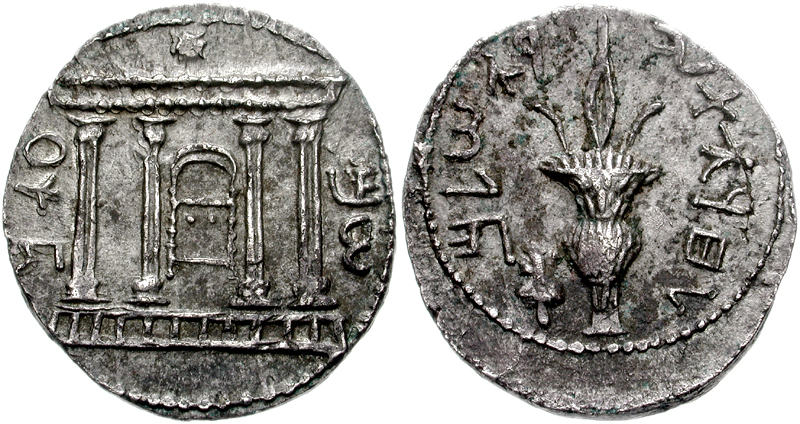
Classical Numismatic Group, Inc. http://www.cngcoins.com, CC BY-SA 3.0, via Wikimedia Commons
Bar Kokhba coin
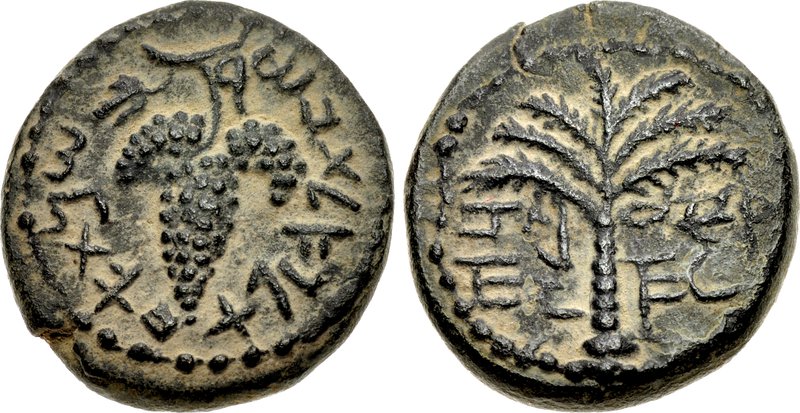
Classical Numismatic Group, Inc. http://www.cngcoins.com, CC BY-SA 3.0, via Wikimedia Commons
Eliezer ha-kohen coin
The traditional opinion is that Eliezer Ha-Kohen, who was regarded as the main religious authority during the Second Revolt, served next to Shimon Bar Kokhba, who was the military leader; this observation is based on the fact that their coins are typologically similar. Judging from the imagery on the coins minted by Shimon, his movement continued the efforts of Eliezer to secure liberation from Roman rule. Some of Shimon’s coins, minted in the 1st year, used the same symbols and slogans that had previously been inscribed on the coins by Eliezer96. In addition, on the coins struck from his 2nd and 3rd years, the image of the façade of the Temple appears next to the words “For the Liberation of Jerusalem”. This suggests that the rebels associated the concept of “Jerusalem” with an idea of the restoration of the Temple50. The diminishing of importance of Eliezer on the Shimon’s coins minted on the 2nd and 3rd years suggests that Shimon replaced him as leader of the Second Revolt. This probably explain why the name of Eliezer does not appear in any of the external sources on the Second Revolt, which were written during the period after its destruction, and which all consider Bar Kokhba as the only leader at the end of the upraise. Several questions can be asked here. Did the coins bear the image of the Temple as a reflection of the ideology of the rebels to restore it or construct a new one, or was it a depiction of an actual Temple? More intriguingly, it is very strange that only five of these coins were ever found in Jerusalem - does this mean that the city was, in fact, never captured by the rebels? Was Eliezer still alive when the Shimon’s coins were minted, or they postdate his time, which means that the dies of Eliezer’s coins were reused later? Finally, when and under what conditions did the attitude of the sectarians changed so dramatically towards Shimon that he started to be called the Man of Lies?
4. R. Gamliel as the Wicked Priest; the Rabbis as the Builders of the Wall; R. Akiva as the Preacher of Lies; Bar-Kokhba as Manasseh/ the Man of Lies
The Pesher Habakkuk explicitly refers to the period of persecutions of the sectarians initiated by the Jewish leader named kohen ha-rasha, the Wicked Priest; it related that “The Wicked Priest was called by the true name at the beginning of his standing, but when he ruled in Israel, his heart became large, and he abandoned God, and betrayed the laws for the sake of riches… and he stole and hoarded wealth from the brutal man…and he seized public money…” (1QpHab, col. 8). This statement would suggest that although the Wicked Priest initially intended to behave in a correct way towards the sectarians, his behavior changed dramatically due to the change in his status that resulted in him assuming political power and pursuing his opponent into exile; this remark corresponds to the initial period of close cooperation between the two Jewish leaders, while it also explains that it is only much later a major conflict arose between them. In my opinion, it is a reference to the confrontation between R. Eliezer b. Hyrcanus and his brother-in-law, R. Gamliel II. The apparent change of heart of the Wicked Priest could have been a result of a change of the status of R. Gamliel that occurred after his recognition as the chief representative of the Jewish nation either after his visit to Rome at the end of the reign of Domitian, c. 95 CE, or during his trip to Syria to “gain permission” from the hegemon (M. Ed.7:7). At the time, the neutral title of Nasi (“Prince”) was accepted by R. Gamliel, who was probably the first Jewish leader to use this title officially.
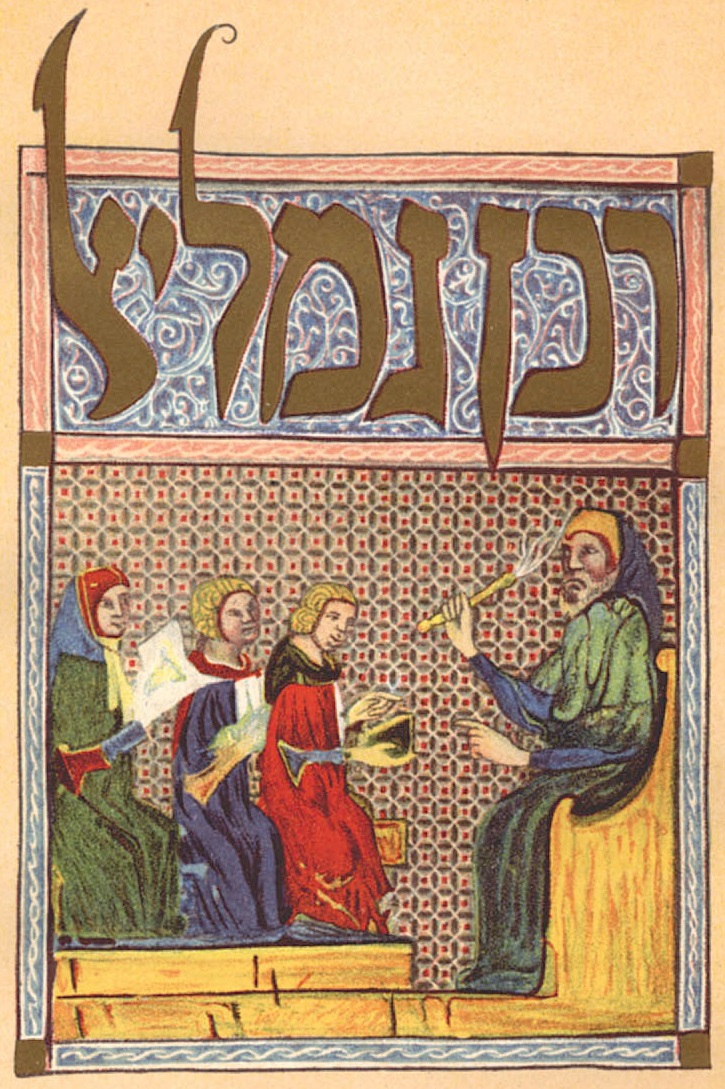
Public domain, via Wikimedia Commons
Rabban Gamliel in a medieval miniature
R. Gamliel’s move to excommunicate his religious rival, R. Eliezer, may have been caused not only by religious, but also by political divergences. R. Gamliel’s main achievement was the unification of the nation, following the hurban, under the rule of the Sanhedrin of Yavneh, who embraced the principles of Halakha issued by the school of Hillel; this suggests that it was due to his dedicated efforts that all the various sectarian movements within Judaism were suppressed, and the Sanhedrin of Yavneh remained the only significant religious and political authority in Judea28. Apparently, the scale of the sectarians’ influence was significant enough for the rabbis of Yavneh to issue a special curse – Birkat ha-Minim – on the “heretics” that was purposely introduced into the prayer books as the twelfth of the Eighteen Benedictions of Amida, to deny any possible connection to the “heretics”83,141. It is probably because he had been appointed by Domitian, to collect the Jewish tax known as fiscus Iudaicus, that R. Gamliel was accused in the Pesharim of “accumulating wealth” and “robbing the poor people”.
The Pesher Habakkuk also refers to the “impure and abdominal deeds” by the Wicked Priest: he “performed repulsive acts in Jerusalem and defiled the Sanctuary of God” (1QpHab, col. 12). The reference to the state of sacrificial practices, which were considered ritually impure in the Pesharim is unlikely to be related to the situation pertaining in the Second Temple, but instead was a reference to the state of affairs during the Yavneh period. From the sectarians’ perspective, as the Temple in Jerusalem remained in a state of ruin, no sacrifices should have been offered there until the new Temple had been built122. The idea of building a Third Temple that came into focus of the ideology of the Second Revolt, found its expression in the Temple Scroll, the longest known sectarian document that was discovered among the Scrolls; it was written in the first person, suggesting that Moses had received it directly from the Angel on Mount Sinai151. Its author not only rejected the existing sacrificial practices as being “polluted”, but also provided detailed instructions as to how to conduct them properly avoiding ritual impurity; he also detailed plans for building a Third Temple in Jerusalem of vast proportions; its description was based on the dimensions borrowed from the Tabernacle of Moses from the Torah as well as Prophet Ezekiel’s vision. Some of the administrative and criminal laws referred to in the Temple Scroll relate to the revival of the Mosaic laws, but in order to apply these laws in reality, the Jews would have to achieve political independence; this implies that the Temple Scroll was composed after the independence of Judea was declared, and there were expectations that the Temple would be rebuilt soon. Taken this historical context into consideration, it is conceivable that R. Eliezer b. Hyrcanus was the author of the Temple Scroll.
Since the title “Priest” normally referred to the High Priests of the Second Temple, it was thought that this was a reference to one of the Temple priests; but it must be considered that, during the entire Herodian period and until the hurban, the Sadducean priests maintained complete responsibility for the maintenance of the Temple, it seems highly unlikely, therefore, that the sectarians, who regarded themselves as the Sons of Zadok, would have opposed the Sadducean High Priests. There is, however, a good possibility that, regardless of the hurban, for a long time until the end of the Second Revolt, the Jews continued to offer sacrifices to the Temple’s altar27,59. Thus, the actions of the Wicked Priest suggest that it is likely that someone like Gamliel acting as the High Priest during the Yavneh period was responsible for sacrifices, but since he was not of a priestly lineage, he may have been referred, by the sectarians, as an “illegitimate”, “wicked”, priest.

Illustrator of Henry Davenport Northrop's 'Treasures of the Bible', 1894, Public domain, via Wikimedia Commons
High Priest Offering Incense on the Altar
By the time of R. Yehuda Ha-Nasi, the editor of the Mishnah c. 220 CE, the Jews had already been expelled to the Galilee, and the relevance of sacrifices that they were now unable to perform was now diminished, nevertheless, this book preserved a great deal of information regarding the opinions of various rabbis’ on the subject of sacrificial offerings. The Mishnah relates that when one of the last rabbinic leaders of the Yavneh period, R. Ishmael b. Elisha, who was named Kohen Ha-Gadol (High Priest), entered the Holy of Holies, and was asked by God for a blessing, he replied by asking God to treat Israel mercifully (Br.7a). This story shows him being in charge of the sacrificial rituals in the Day of Atonement and the text implies that, a part of the sacrificial altar, perhaps some sort of Sanctuary, existed in the Hadrianic period, and that R. Ishmael could have been serving as the High Priest of the Temple; it also implies that he might be in charge up until the time that Jerusalem evolved into Aelia Capitolina. During the early Yavneh period, however, the sacrificial rituals were supervised by R. Gamliel, and it is told that he ordered his servant to prepare lamb for a Passover sacrifice (Pes. 7.2); he is also reported to have visited the ruins of the Temple, accompanied by R. Joshua and R. Akiva, with the purpose of offering there (Sif. to Deut. 43)57.
The Pesharim explicitly refer to the period of persecutions of the sectarians which were initiated by the Wicked Priest. The Pesher Habakkuk relates that the Wicked Priest assaulted the Teacher of Righteousness in his place of exile, while visiting him on his “Day of Atonement” - Yom Kippur (1QpHab, col. 11). This story highlights a principle disagreement that arose between the two leaders in establishing the days of the festivals, which can only be explained if the sectarians used a different calendar from that of the rest of the Jews. In fact, R. Gamliel took the liberty of introducing a universal solar-lunar calendar into Judean practice, but this innovation did not pass without opposition within the rabbinic circles. It is reported that in a dispute about fixing the calendar, R. Gamliel humiliated R. Joshua b. Hananiah by asking him to show up with his "stick and satchel" (weekday attire) on the holy day which, according to R. Joshua's calculation, was Yom Kippur (Rosh Hash. 25a, b). This arrogant behavior led to the revolt by the rabbis against R. Gamliel, with the result that the Sanhedrin temporarily installed R. Eliezer b. Azariah as the new Nasi. R. Gamliel was later reinstalled, and probably retained his position until the events in Lydda that took place in 116 or 117 CE. At that time, all the Jewish leadership that remained in Lydda was removed by the Romans and many Jews were killed. The Talmud frequently refers to these events as the “slain of Lydda” (Pes.50a; B. B. 10b; Eccl. R. IX, 10).
It was reported in the Pesher Psalms, that the Wicked Priest was caught, and punished by the “wicked ones of the nations”, “for the wickedness against the Teacher of Righteousness and the members of his council God delivered him into the hands of his enemies to disgrace him with a punishment, to destroy him with bitterness of soul” (1QpPs, col. 9). It seems that this note leaves an impression that the persecutions of the sectarians occurred shortly before the tragic end of R. Gamliel during the events in Lydda; it means that the excommunication of R. Eliezer occurred c. 115 CE. This chronology better fits the remark of the Covenant relating to the “twenty years” period when the sectarians “walked like blind”, that passed between the death of the Teacher of Yahad and the arrival of the Teacher of Righteousness.
The Admonition of the Covenant completely ignores the figure of the “Wicked Priest”, but prominently highlights the primary ideological rival of the sectarians as the “Preacher of Lies” ( mettif kazzav); he “sprinkled upon Israel waters of falsehood and led them astray in a chaos without a way, bringing low the everlasting heights and departing from the path of righteousness, moving the border...surrendering them to the avenging sword” (CD I, 13-21; XIX, 25). He was considered responsible for the internal division that happened within the sectarian community: “he led astray many to build a city of emptiness with bloodshed and erecting a community by subterfuge for his own renown, wearing out many by useless work and by making them conceive acts of deceit…”(1QpHab, col.10). In my opinion, this figure might be identified as R. Akiva, the leading rabbinic authority on matters of Halakha in the time of Hadrian, and the only prominent rabbinic leader to support Bar Kokhba during the Second Revolt. R. Akiva began his studies in Lydda with R. Eliezer b. Hyrcanus, but later founded his own school of thought in Beneberak; at the time of the conflict between R. Gamliel and R. Eliezer, he sided with the former. The Mishnah attempts to diminish the scale of the conflict that arose between the two leaders by relating that when the final decision to excommunicate R. Eliezer was taken, R. Akiva appeared before him in mourning clothes and, seated at some distance from him, addressed him with the words: "My master, it appears to me that thy colleagues keep aloof from thee". Because R. Akiva broke the news gently, it is told, R. Eliezer who had the power to destroy the world, annihilated no more than one-third of the crops worldwide and burned only those things that were within his field of view (B. M. 59b; M. Kat. 3:81a). Although it is reported that R. Akiva regretted not opposing enough his teacher’s excommunication and publicly mourned his death while accompanying his funeral procession from Caesarea to Lydda, crying outload and cutting himself (Sanh. 68a), this account appears to be a later reworking of the earlier version of the account in Y. Šabb. 2:5, 5b124.
The Pesher Nahum (4Q169 Frags. 3–4, col. 4.1) referred to a group identified as the “House of Peleg who joined Manasseh”. In addition, the Covenant (CD XX, 22) reports that “House of Peleg went out from the Holy City, and learned about God at the time when Israel sinned and defiled the sanctuary”; the Covenant suggested that these people were to be “judged individually”. Since the term “Peleg” originates from the Hebrew term meaning “to separate”, it can be assumed that this group was originally related to the sectarians but decided to separate from them at the later stage. It seems that the Pesher Habakkuk (col. 5) refers to the same group as the “House of Absalom”; they were accused of “keeping silent at the time of the reproach of the Teacher of Righteousness, and did not help him against the Man of Lies”. The use of the name Absalom was meant to evoke association with the Biblical figure of Absalom, the third son of King David, who betrayed his father. The Pesharim also consider them as “Traitors of the Covenant”, who were all expected to soon “perish by the sword, by hunger, and by plague” (4QPs, col. 2). This might be a reference to the great plague that came in the middle of the Second Revolt causing the deaths of twenty-four thousand followers of R. Akiva (Yev. 62b). The later Jewish authority, Rav Sherira Gaon, however, lists sh’mada as the source of their deaths, meaning that the students of R. Akiva who supported the Bar Kokhba Revolt, were martyred by the Romans; this event was referenced in the statement to those “who derided and went to the punishment of fire” (1QpHab, col.10). Following his capture by the Romans, R. Akiva was subjected to combing, a torture in which the victim's skin was flayed with iron combs (Ber. 61b) and died.
The Covenanters associated the figure of the Preacher of Lies with their main adversaries, a Jewish group who were referred as the “Trespassers” ( mesigei gvul). They arose “at the time of the destruction of the land, moved the boundary, and led Israel astray when the land became desolate”; the same group was also called by the Covenanters the “Builders of the Wall” (bonei ha-hets) (CD IV, 19-20; V, 20-21; VIII, 12, 18); they also complained that they did not accept their concept of monogamy that permitted a man “taking two wives during their lifetime” (CD IV, 20-21). In my opinion, this group cannot be identified as the Pharisees on account of a reference to their appearance during the period known as the “destruction of the land” (CD V, 20), suggesting that this was a reference to events that occurred after the hurban. This interpretation allows this group to be identified as the rabbis, the spiritual successors of the Pharisees; their unusual name may be a reference to the famous notion held by the rabbis, “building a fence around the Torah” (Pirkei Avot 1:1), in order to ensure the fulfillment of the Torah Commandments.
The Covenanters, who referred to themselves as “Judah”, and to the rabbis of Yavneh as “Ephraim”, declared their superiority over “Judah” during recent times: “Ephraim departed from Judah when the two houses of Israel split, Ephraim lorded over Judah” (CD VII, 12-13); in this way they evoked an association with the tragic split of the Samaritans, who believed to be descended from the Israelite tribe of Ephraim. It follows that the Covenanters recognized that, during the Yavneh period, the rabbis succeeded in convincing the Romans of their unique role as the deputies of the Jewish nation. According to the Pesharim, the adversaries of the sectarians, who were commonly associated with Jerusalem, were regarded as dorshei halakot – the “Seekers After the Smooth Things”. This name might have been an allusion to the “softer” attitude towards the matters of Halakha displayed by some rabbis, or, instead, because of their close corroboration with the Romans. During the Second Revolt, it is probable that the city of Jerusalem, itself, remained in hands of the Roman military, which was supplied by the Jews, who were opposing the Second Revolt, thus it seems likely that the Jewish population of Jerusalem aided in process of rebuilding the city before it finally turned into Aelia Capitolina.
Apart from a group of rabbis, commonly identified as “Ephraim”, the Pesher Psalms refers to another powerful group, known by the name of “Manasseh” that seemingly took their name from a historic tribe of Israel that was apparently coincident with the name of the ancient “idolatrous king” of Judea, Manasseh. Both of these groups had been blamed for attacking the leaders of the sectarians, and it was suggested that this would result in them being persecuted by the enemies: “The wicked ones of Ephraim and Manasseh will seek to lay hands on the Priest and the man of his counsel in the period of refining that is coming upon them. But God will ransom them from their hands, and afterwards they will be given later into the hand of the ruthless one of the Gentiles for judgment” (4QpPs, col.2). The ruler identified as “Manasseh” was in charge of Judea, but was destined to die or go into the exile: “Manasseh’s reign over Israel will be brought down…his wives, his children, and his infants will go into captivity… his warriors and his honored ones (will perish) by the sword” (4QpPs, col. 4). This seems to be a hostile prophecy to the fate of Bar Kokhba, the last Jewish ruler of Judea.
Despite Bar Kokhba’s association with the messianic “Star” prophecy from Numbers 18:24 generously granted by R. Akiva (Y.: Ta'anit 4:15), hence his nickname Bar Kokhba – the “Son of a Star”, in Aramaic – it was argued that the “Star” prophecy should be applied to their leader, the “Interpreter of the Law”; and it was only the “Scepter” prophecy that could be associated with the figure of “Nasi of the entire Congregation”, who was destined to lead them into the future decisive battle against their enemies, the Sons of Set (CD VII, 16-21)

Deror avi, CC BY-SA 3.0, via Wikimedia Commons
Bar Kokhba (detail from the Knesset Menorah in Jerusalem)
From a historical perspective, the only time that a dual structure of supreme Jewish leadership can be observed was at the beginning of the Second Revolt71. From the original letters found in the Cave of Letters, it would seem that Bar Kokhba was regarded as secular and military ruler, but the coins also reveal that he was ruling alongside the religious leader, Eliezer Ha-Kohen95. The rabbis gave Shimon the pejorative name, Bar Kosiba – the “Son of Lies”121, while the Covenant and the Pesharim refers to him as the Man of Lies (ish kazzav) (CD XX, 14-15), who “led astray many with words of deceit, for they chose empty words and did not listen to the Interpreter of Knowledge” (4QPs, Frag. 1, col.1) and publicly confronted the Teacher of Righteousness, when the “Man of Lies worked against the Teacher of Righteousness and rejected the Torah (of the Teacher) in the midst of the entire Congregation” (1QpHab, col. 5). These quotes suggests that a conflict arose between the two leaders of the revolt that resulted in Eliezer Ha-Kohen being removed from power.
The initial approach of the sectarians towards the political situation pertaining in Judea at the beginning of the Second Revolt seems to have been supportive, and their books are full of expectations of the coming failure of the Romans rule. According to 4QMMT, the Halakhic Letter, also known as Miqsat Ma’ase ha-Torah (Some Observances of the Law), a disagreement arose between the sectarian and rabbinic leaders during the preceding era, resulting in them breaking away “from the multitude of the people”. However, they were now willing to join the common cause on condition that their views were accepted. The authors of the letter, who were referring to themselves in the plural form of “we”, recognized the legitimacy of the addressee, referring to him in the single form of “you”. Since they also compared his actions with those of the great Jewish kings of antiquity, David and Solomon, paying respect to his “wisdom and knowledge of the Torah”, so it seems that they believed that he must be regarded the rightful ruler of Israel. Nevertheless, the sectarian leaders still persuaded him to accept their ideas with regards to matters of ritual purity and the calculations of the calendar. In my opinion, the Halakhic Letter cannot be a private letter sent from the Teacher to the Wicked Priest, because the sectarians denied the legitimacy of the latter. Instead, it appears to be a letter that was probably written by the sectarian leaders, and its addressee was Shimon Bar Kokhba himself. Its authors hoped to convince their addressee to renounce the influence of the rabbis, who were not supportive of the Revolt anyway125, and instead, accept his authority in religious matters, but this appeal met with a negative response of Bar Kokhba, and as a result of his categorical rejection of the sectarian’s demands, the public conflict came about, which was referred by the Pesharim as a clash between “Judah” and “Manasseh”.
5. The Romans of Adiabene as the Kittim of Ashur; Emperor Hadrian as the Head over the Kings of Greece/ King Demetrius/ Man of Belial
The invasion of Judea by the “Kittim” provides the principle background for the historical events recorded by the Pesharim. According to the Pesher Habakkuk, the Kittim were a "cruel and determined people; swift and powerful in battle; destroying many with the sword; advancing quickly to destroy and pillage the cities of the country; trampling the land with their horses and with their beast; coming from the islands of the sea like an eagle; increasing their wealth with all their booty like the fish of the sea; sacrificing to their standards; their weapons of war are the objects of their reverence" (1QpHab, col. 2, 3). The majority of scholars agree that these particular characteristics closely resemble what we know of the Roman military, especially their association with an eagle, which was one of their symbols, and also the offering of sacrifices to their military standards. The Pesharim used the term “rulers” when referring to the chiefs of the Kittim, describing them as military leaders, who were “coming one after another to destroy the Earth” (1QpHab, col. 4); this is a reference to the commanders of the various Roman legions sent to Judea to quell the resistance.
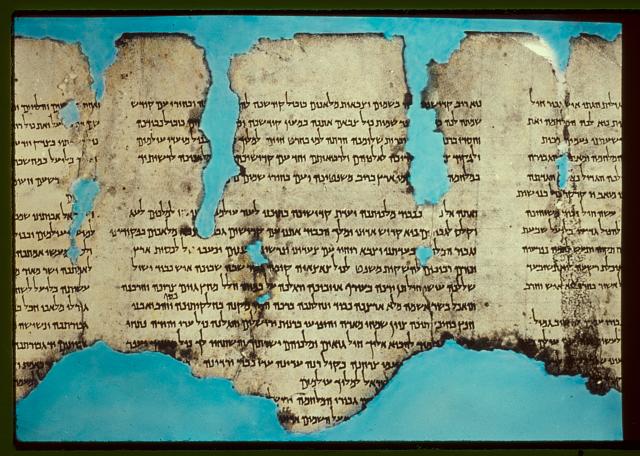
Matson Photo Service - American Colony Jerusalem, CC0, via Wikimedia Commons
The War Scroll - Dead Sea Scrolls
The War Scroll (1QM) provides detailed instructions for the organization of a Jewish army and reveals the tactics used by the rebels to fight their enemies; it “foresees” an eschatological war between the “Sons of Light” (bnei or) – the “Sons of Israel”, and the “Sons of Darkness” (bnei hosheh) – the Kittim of Ashur130. The straightforward identification of the Kittim in the War Scroll as the Romans raises the question as to why the Jews were unable to distinguish between an enemy who came from the west of the Mediterranean and one who arrived from the east; it also fails to explain their Assyrian identity, since the Biblical name Ashur (Assyria) was not normally used in Jewish literature to refer to Rome. Another proposal was to identify the Kittim of Ashur as the Seleucids, which would date the War Scroll to the 2nd century BCE; however, it was convincingly shown that the War Scroll contains a description of warfare that was similar to that used by the Romans150. The historical reference in Pesher Nahum (Frgs. 3-4, col. 1) differentiates between the Rulers of Kittim and Antioch, the King of Greece, effectively eliminating the suggestion that the Kittim of Ashur could be identified as the Seleucids. It was suggested that the term the “Kittim of Ashur” used in the War Scroll was a reference to the Roman army stationed in Syria, which in medieval times was occasionally referred to as “Assyria”, there is, however, no information in existing sources concerning any military resistance to the Romans in the territory of Syria either in 63 BCE or during the time of the Jewish Revolts.
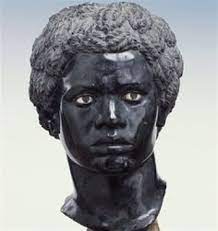
Lusius Quietus
Nevertheless, in my opinion, serious consideration should be given to the fact that, after Trajan conquered the Jewish Kingdom of Adiabene in 115-6 CE, he renamed it the “Roman Province of Assyria”, and proceeded to station Roman forces there. The great suffering of the Jews of Adiabene, and the rumors of the slaughter of thousands of Jews there, sparked the beginning of the Jewish Diaspora Revolt, that began in Libya and Egypt, before spreading to Cyprus, and later to Judea112. It is possible that the same Roman legions that were formerly stationed in Adiabene, were relocated to Judea in 117 CE under the leadership of the Roman general, Lusius Quietus, the conqueror of the Jews of northern Mesopotamia. After assuming command of the Roman army in Judea, Quietus laid siege to Lydda, where the rebels had gathered; when Lydda was taken, the rebellious Jews were executed. This theory can be further strengthened by the subsequent identification of the Kittim in Mitzraim (Romans in Egypt) – mentioned in the War Scroll as another enemy – as the Legio II Traiana Fortis stationed in Egypt. Apparently, in 1978, a milestone was discovered in the road that led from Acre to Sepphoris that attests to the presence of the Legio II Trajana there in 120 CE69.
The origin of the name Kittim, which would not normally be used by the late-antique rabbinic sources in respect of the Romans, is another subject of discussion. The Book of Daniel 11:30 mentions the “Ships of the Kittim” in relation to the military encounters between the Seleucid and Roman forces in the 170s BCE. Although this name was translated in the Septuagint as the Romans, and it was accepted that the Pesharim took this name from Daniel, it might also be derived from the Balaam’s Third Prophecy in the Torah (Num. 24:24). However, 1 Maccabees 1:1 clearly identified the Kittim as the Macedonians, claiming that Alexander the Great “marched out from the land of the Kittim”. Jubilees 37:10 describes that the army enlisted by the “Sons of Esau” to fight “the Sons of Jacob” included Kittim among its troops; scholars have regarded this as being a reference to the Greeks, but this is not at all certain. In my opinion, and as will be shown below, Jubilees itself was not a Hellenistic treatise, but it was composed in the Roman period, therefore its reference to the Kittim must refer to the Romans. Another possibility to consider, however, is that the unusual name of the Kittim only become popular during the events of the Great Jewish Diaspora Revolt when it was associated with the “Kitos War”, in turn, the name might have taken from Quietus, the main enemy of the Jews. This name, when it was cross-referenced with the Biblical term, was commonly used by the sectarian Jews from the beginning of the Great Diaspora Revolt and until the end of the Second Revolt.
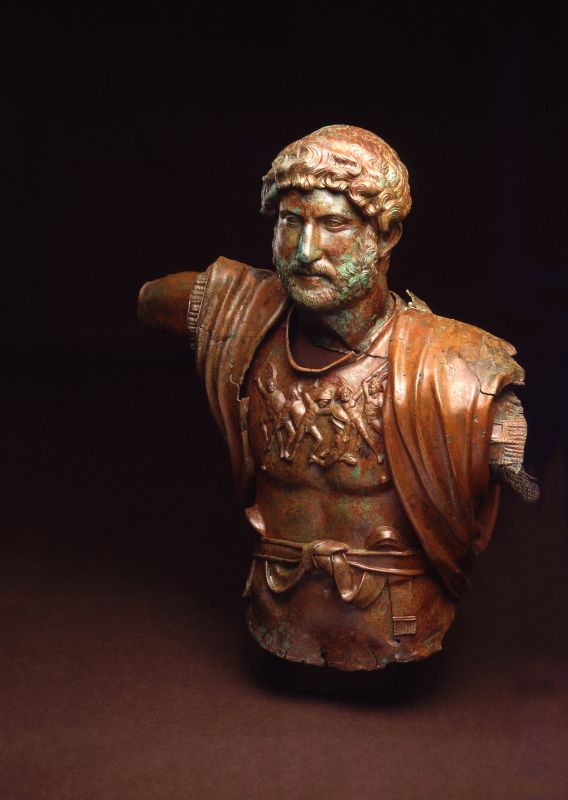
Photo © Israel Museum, Jerusalem, by David Harris
Bronze statue of Hadrian from Tel Shalem in Israel Museum
The Pesher Nahum also mentions the figure of a military commander closely associated with the Kittim invaders – the “Angry Young Lion” (kefir ha-haron), and recounts dramatic stories of his cruel execution of the rabbinic Jews: "The Angry Young Lion struck (the simple folk of Ephraim with his nobles and the men of his counsel…brings vengeance on the Seekers After the Smooth Things…hang men up alive…filled his den with a mass of corpses…hanged men alive from the tree, committing an atrocity like never been seen before in Israel" (1QpNah, Frags. 2-3, col.1). The identity of the Angry Young Lion remains a mystery, and numerous identifications have been proposed; in my opinion, it seems very probable that the Angry Young Lion can be identified as Sextus Julius Severus, an accomplished Roman general, who was appointed by Hadrian to be a governor of Britannia68. He was subsequently transferred to Judea to help suppress the Second Revolt and was seemingly successful where all the others had failed. It was convincingly shown by Gregory Doudna that the figure of Angry Young Lion was portrayed in the Pesher Nahum as a military leader of the Kittim rather than a Jewish leader, and was considered responsible also for bringing an end to the rule of the “doomed ruler of Israel”, Manasseh36, in turn, I suggest that this leader should be identified as Bar Kokhba. His actions can be compared with the evidence of the Roman historian Cassius Dio 69:12-14, who relates that during the suppression of the Revolt, the Romans practiced mass punishment of the people, including crucifixion, razing villages to the ground and taking people into captivity. This proposal seems acceptable since a lion was a symbol of the Roman Legio XIII Gemina to which Severus belonged.
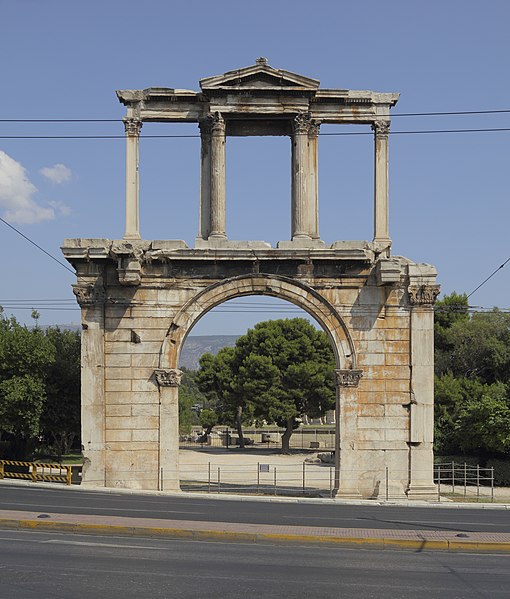
A.Savin (Wikimedia Commons · WikiPhotoSpace), CC BY-SA 3.0, via Wikimedia Commons
Arch of Hadrian - Athens
The Covenant explicitly referred to the figure of the chief enemy of the Jews, the powerful foreign ruler who was known as the “Head over the Kings of Yavan (Greece), who will come to wreak vengeance upon the dragon nations” (CD VIII, 10-12; XIX, 24). In my opinion, these references relate to Hadrian who replaced Trajan in August 117 CE; he was a philhellene who promoted Hellenistic culture in all the countries occupied by him, which is probably why the Covenant considered him responsible for introducing “Greek ways” into the cultural life of Judea. Hadrian was already appointed the eponymous archont of Athens in 112 CE when he was regarded as an ardent admirer, and a generous protector of Greek culture11. In 124 CE, upon his arrival in Greece, Hadrian assumed a commitment to the people of Athens; at their request, to revise their constitution and to rebuild ancient shrines; he also created new ones. To bring the Greeks together, in 131/2 Hadrian created a league of Greek city-states named the Panhellenion, and in this way he become the only Roman Emperor to assume the position of a “head over the Greek kings”.
Unlike the Pesharim, the Covenant did not use the name Kittim in connection with the enemies of the sectarians, but instead followed the approach of other Scrolls and associated them with the “Men of Belial” (“wicked”, or “worthless”); within the “three nets of Belial” it included improper sexual behavior, arrogance, and the “defilement of the Sanctuary” – the desecration of the Temple (CD IV, 17-18). In my opinion, this latter reference alludes to the activities of Hadrian, who, according to Cassius Dio 69.12.1, founded the city of Aelia Capitolina, in the place of Jerusalem, and erected the Temple of Zeus on the Temple Mount. The identity of Hadrian as the Man of Belial, who attempted to build the “wicked” city, is endorsed by the Pesher Joshua which refers to the Biblical curse of Joshua. According to this curse, the children of the Man of Belial, who would attempt to rebuild Jericho, would die: “At the cost of his firstborn he shall lay its foundation, and at the cost of his youngest he shall set up its gates” (Josh. 6:26), and he would then remain childless. This evidence was further confirmed by 4QPseudo-Ezekiel: ”A Son of Belial will plot to oppress my people, but I will not allow him to and his dominion will not exist, but he will defile a multitude, and his offspring will not remain” (4Q386, col. 2: 3-4). The Pesher Joshua also stated that being childless, the Man of Belial instead appointed “two men of violence” to succeed him but the first one died soon afterwards. Although Hadrian had no children through his marriage with Sabina, he appointed two of his adopted sons as his heirs, and they were both regarded as his co-rulers. In 136 CE, he adopted one of the consuls of the year, who took the name Lucius Aelius Caesar as Emperor-in-waiting; he died not long afterwards, on 1 January 138 CE. Later, in February 138 CE, shortly before his death in July 138 CE, Hadrian adopted Antoninus Pius who succeeded him as the new Emperor.
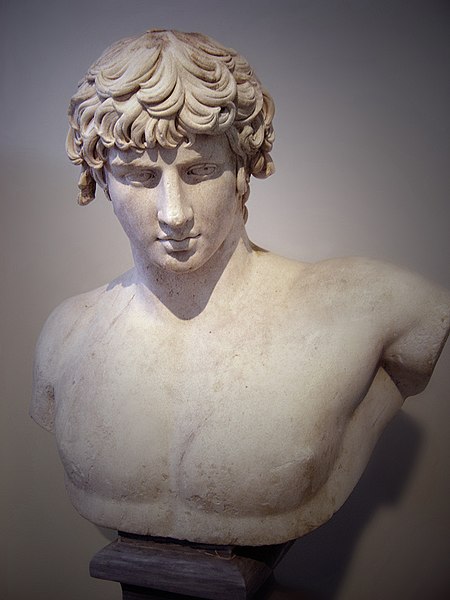
Ricardo André Frantz (User:Tetraktys), CC BY-SA 3.0, via Wikimedia Commons
Antinous's marble portrait
The Scroll referred to as 4QPseudo-Ezekiel reports the death of the person identified as the “Wicked One who will be slain in Memphis” (4Q386, col. 2:6). This event was confirmed by statement of another Scroll, the Psalms of Solomon: “his body was carried about on the waves in great shame and there was no one to bury him”. Such an unusual description of the death of the Wicked One probably describes the sudden tragic death of Antinous, Hadrian’s favorite and lover, who committed suicide during their joint trip to Egypt in late autumn 130 CE by throwing himself into the waters of the River Nile. His death severely affected the spirit of Hadrian, who created a cult around him naming temples after him and a city in Egypt. Considering that the identification of the events mentioned in these references is correct, it might be inferred that the Scrolls continued to refer to the events during the last years of Hadrian’s reign for a long time after the failure of the Revolt.
The statement in Pesher Nahum (Frags. 3-4, col. 1) that “Demetrius, king of Greece, entered Jerusalem on the counsel of the Seekers After the Smooth Things” confused many scholars since it also stated, in the same passage, that no foreign king had ever entered Jerusalem since the time of Antiochus up until the rise of the “rulers of the Kittim”. Since the figure of Antiochus could only relate to the Seleucid king Antiochus VII Sidetes, who captured Jerusalem in 134 BCE, it has not been possible to provide an identification for “King Demetrius” within the Hellenistic period. This information appears to allude to the first visit of Hadrian to Jerusalem, which almost certainly took place in agreement with the rabbis. This suggestion can be further strengthened by the accusations of the corroboration of the rabbis with the Romans made by Pesher Habakkuk (col. 4); it reports on the conspiracy with the Kittim, who advanced “on their counsel”; according to the Pesher Nahum, the Kittim came “on the counsel of the Seekers After the Smooth Things” (Frags. 3-4, col.1). In my opinion, this group can be identified as the followers of R. Meir, which at first stayed in Jerusalem where they supplied the Roman Legio X Fretensis but remained abroad during the Hadrianic persecutions.
It was probably during this visit that Hadrian decided to entrust the reconstruction of Jerusalem to the Greek intellectual, Aquila of Sinope, who translated the Bible into Greek, and made tempting promises to the rabbinic leaders in regard to the rebuilding of the Temple. The Talmud reports that when Hadrian arrived in Jerusalem for the first time, he was particularly supportive of the rabbis’ idea of rebuilding the Temple. He apparently promised R. Joshua b. Hananiah, the new leader of the rabbis, who had accompanied Hadrian during his trip to Egypt (Hul. 59b) that this would be accomplished soon (Gen. Rab., LXIV, 10). The author of the Epistle of Barnabas XVI, 4, who strongly rejected the prevailing sacrificial practices of the Jews, also seems to indicate that there was an expectation that the Romans would rebuild the Temple68.The Talmud relates that when one of the last rabbinic leaders of the Yavneh period, R. Ishmael b. Elisha – who was named Kohen Ha-Gadol (the High Priest) – entered the “Holy of Holies”, God asked him for a blessing, he replied by asking for God himself to treat Israel mercifully (Br.7a). This suggests that R. Ishmael was in charge of the sacrificial rituals on the Day of Atonement and that, shortly before the beginning of the Second Revolt, perhaps some sort of a Jewish Sanctuary on the Temple Mount already existed. The sectarians opposed to such minor construction, and initiated a campaign for it to be desacralized, since they maintained that a great Temple of enormous dimensions should have been erected, exactly as specified in the Temple Scroll.
In 2014, when the Israel Antiquities Authority conducted salvage excavations in Jerusalem in several areas north of Damascus Gate, a stone fragment bearing an official Latin inscription of six lines was discovered, containing a dedication by Roman Legio X Fretensis to Emperor Hadrian on the occasion of his visit to Jerusalem: “To the Imperator Caesar Traianus Hadrianus Augustus, son of the deified Traianus Parthicus, grandson of the deified Nerva, High Priest, invested with tribunician power for the 14th time, consul for the third time, father of the country (dedicated by) the 10th legion Fretensis Antoniniana”. Interestingly, this inscription portray Hadrian, as the High Priest. The rabbinic text Exodus Rabba 61:5 also points to the active participation of Hadrian in the Temple’s sacrificial rituals, as it says: “R. Shimon ben Yohai said: When Hadrian entered the Holy of Holies…” The date of Hadrian’s famous visit to Jerusalem and of his actions that potentially caused the rebellion, is traditionally established as 129/130 CE, when Hadrian went on a “Grand Tour” on the Roman Near Eastern provinces. However, no precise dates were given by the Roman historian Cassius Dio 69.12.1-2, who is the main external source of our information, although he did connect the beginning of the Second Revolt with the consequences of Hadrian’s visit to Jerusalem22. This dating was recently challenged by Livia Capponi, who suggested that, instead, the first visit of Hadrian to Jerusalem could have occurred before his trip to Alexandria, in August or September 117, soon after his installment as Emperor in 11th August 117 CE21.
Information contained in the Scrolls sheds a new light on the events of this period and allows us to reevaluate its dating as well as reassess the reasons for the visit, as well as the context behind the Second Revolt. The Scroll labelled 4Q248 is a remnant of an apocalyptic work which tells of the actions of a “Greek king”, who visited Jerusalem following his brutal treatment of the population during the siege of Alexandria. A connection was made with the beginning of the rebellion in Judea following the visit of this king:”…and he shall rule over Egypt and Greece, and (against the God of Gods he shall exalt himself). And so they will eat the flesh of their sons and daughters in siege at Alexandria…and he shall return from Alexandria (and) come to Egypt and sell its land, and he shall come to the Temple City and seize it and all its treasures, and he shall overthrow lands of (foreign) nations and (then) return to Egypt. And when the breaking of the power of the holy people comes to an end… (and) the Children of (Israel) shall repent.”20
I believe that this information relates to the attack on the Jews of Alexandria launched by Hadrian, when he came to deal with the Jewish Revolt led by Lucuas, a Jew from Cyrenaica. According to Eusebius46, he declared himself a “Jewish king” and took control of large parts of Libya and Egypt during the years 115-17.
The sources argued that on 24th September, 117 CE, Hadrian personally ordered the restoration of the Egyptian buildings destroyed during the Jewish Revolt and continued to issue decrees relating to new construction projects until the end of October 117 CE. Livia Capponi suggested that Hadrian could only have visited Jerusalem before his trip in Alexandria, in the late August or early September 117, and it is, of course, possible that during the first visit he demonstrated positive intentions towards his Jewish subjects. However, in my opinion, taking into account the information in Scroll 4Q248 cited above, it follows that Hadrian’s second visit to Jerusalem, actually, took place immediately after his dealings with the consequences of the Jewish Revolt in Egypt, that is in November 117 CE. While it is not clear exactly when Hadrian decided to replace Jerusalem with the Roman colony of Aelia Capitolina, establishing a Roman military presence, and building a Temple dedicated to Zeus there, and it is almost universally accepted today that it has happen in 130 CE, it seems that he might have change his approach to the Jewish matters when encountering strong resistance in Alexandria. Lea de Signi argued that the version of Epiphanius, the bishop of Salamis in the 4th century, who probably obtained an access to a local sources when visiting Palestine in 394/5 CE, recorded in chapter 14 of On Weights and Measures40 that bears witness on the date of the beginning for the reconstruction of Jerusalem in 117, can be trustable since it has no hidden agenda but provides a chronological timeframe for the project of the Greek translation of the Bible made by Aquila134.
Cassius Dio 69:14 claimed that an attempt at Hellenization involving the erection of a pagan Temple, became one of the major challenges to the existing status quo and, in fact, sparked the Second Revolt22. According to the 4th century historian and the bishop of Caesarea, Eusebius 4.6.4, however, this project was planned as punishment for the Jewish rebellion. While Eusebius 4.6.3 places the culmination of the Bar Kokhba Revolt into eighteen year of Hadrian (135 CE), Cassius Dio 69:15 mentioned that, not long after the Second Revolt had been quelled, another war was begun by the Alan tribes who invaded the territory of Caucasian Albania, Media, Armenia, and Cappadocia at the instigation of the king Pharasmanes II. Later, however, envoys were sent to Hadrian on behalf of the Parthian king Vologaesus and the Sarmatian Yazygi tribes, who were seeking to make an agreement with Hadrian against the Georgian king and his allies. Kai Juntunen provided an analysis of the sources relating to this diplomatic mission and demonstrated that the Ibero-Albanian conflict and the ensuing diplomacy should be dated to the middle period of Hadrian’s reign, c. 125-27 CE74. Since these events happened after the Second Revolt, this suggests that it ends before 125 CE.
The exact chronology and the precise sequence of events have been topics of endless discussion between scholars3,47,155, but it must be remembered that neither of the sources were a contemporaneous record, but rather later reflections on the events. The account of Eusebius seems, however, the more biased one, since this Christian writer wanted to explain that the Jews were being punished because of their behavior towards the Christians. In order to reconcile the evidences from different sources, I would like to propose that the Great Diaspora Revolt that took place at the end of Trajan’s reign, in 115-117 CE, was immediately followed by the Second Revolt that occurred in Judea at the beginning of Hadrian’s reign, in 118-120 CE. This date supports the suggestion of Martin Goodman that Hadrian’s policy towards the Jews of Judea, which aimed to eliminate them politically and purge their religion through a process of Hellenization, was, in fact, a direct continuation of the strategy instigated by his mentor and predecessor, Trajan54.
Epiphanius reported that while Hadrian remained in Egypt and in Syria, the Jews remained quite only rebelling when he left for the region of the Danube in 11840, probably in order to respond to the invasion of the Yazygi. He also related that the first Hadrian’s visit to Jerusalem occurred some forty-seven years after Titus’ desolation of Jerusalem (in 70 CE), which means that he was referring to an event that has happened in 117 CE. The Scroll 4Q248 also reports that the rebellion in Judea started after Hadrian arrived in Jerusalem following his visit to Alexandria, indicating that these events were dated towards the end of 117 CE. The evidence of the Testament Levi, one of the apocalyptic Scrolls of Qumran which placed the beginning of the Messianic era at the end of the Seventh Week of the Seventh Jubilee beginning with the era of rage, that is 49 years after the fall of the Temple, concurs with the Talmudic reference that fifty-two years passed between the time of the destruction of the Temple and the failure of the Second Revolt, culminating in the year of troubles (Lam. Rab. II, 2,4); this event in 120 CE might correspond with the rabbinic chronological calculations that dates the final destruction of the Temple to 68 CE, as recorded in Seder Olam Rabbah 30. I would like to propose that the actual chronology of the Second Revolt was quite different from the one commonly accepted until now by scholars, and that, instead of the significant gap between the end of the Great Diaspora Revolt in 117 CE, and the beginning of the Second Revolt that was previously dated in 132 CE, the Second Revolt started almost immediately after the end of Great Diaspora Revolt. This sequence of events suggests that the traditional chronology of the Second Revolt should be reviewed, and that its beginning should have be dated to around 118 CE.
This dating can be further corroborated by numismatic evidence. Several coins were issued in Tiberias in 119/20 CE: one represents Nike, the goddess of victory, carrying a palm-branch and a wreath crown, and another portrays Zeus seated in a temple; this could have been the Hadrianeion built in Tiberias in Hadrian’s honor, or a temple of Zeus in Jerusalem. According to Edith Smallwood, the portrayal of Nike might be a reference to the successful Roman campaign against the Jews, after which the building projects planned by Hadrian were initiated135. More meaningful was the cessation of Jewish minting at Sepphoris, an important Jewish center in the Lower Galilee; in early Trajan’s days coins with his portrait, on one side, and various Jewish symbols depicted on the other, were struck there. In Meshorer’s opinion, this provided evidence that the mint was no longer able to operate due to unrest at the end of Trajan and the beginning of Hadrian’s reign93. I would like to point out that among hordes of coins hidden by the rebels, coins minted by the rebels were usually found next to the coins minted by Trajan154. Some of the rebels coins were overstruck on the silver Roman denarius of Trajan, while only a few coins dated from the Third Year were overstruck on the bronze coins of Hadrian issued in Gaza to commemorate the third year of his visit there95; the date of the Gaza mint should be calculated according to Hadrian’s visit in 117. It seems that Trajan’s coins would not be so popular in the case if the Second Revolt had happened towards the end of Hadrian’s reign, since by that time would have been expected in circulation much more coins minted by Hadrian.
Dating the beginning of the Second Revolt to 118 also explains why the last definitive record, in the sources, of the Legio XXII Deiotariana, is from the year 119. The inscription made in the second year of the Revolt mentioning this legion in connection to the aqueduct reparation which was undertaken in Caesarea sets its last known location to Judea77. It suggests that it was disbanded due to the heavy losses it suffered during the Second Revolt making the war the most plausible explanation to its disappearance. However, this dating seemingly contradict the evidences originating from the archive of a Jewish women, Babatha from Mahoza, that dates between 120-132 CE and found in the Cave of Letters, where Bar Kokhba’s letters were also kept, providing evidence that this period was quiet62. In this case the observation by Yigael Yadin that Bar Kokhba’s letters were written following the Babatha’s ones149, should also be reconsidered. It can be tentatively suggested that the Jewish resistance took place in two different stages during the Hadrian reign: one occurred in 118-19 CE, under the leadership of R. Eliezer, and another in 132-35/6 CE, under the leadership of Bar Kokhba.
6. Who wrote the Books of Enoch and the Jubilees, and when?
The identity of the sect of Qumran is further revealed through the study of its library that included, in addition to different Biblical Scrolls, many sectarian books that were unknown to the rabbinic tradition. Scholars have suggested that most of the Apocrypha and the Pseudepigrapha literature of Qumran is from the Hellenistic Age but since, for some reason, it was regarded as “heretical” by the rabbis of Yavneh, they were not accepted as a part of the Masoretic Hebrew Bible. I believe that the total lack of Hellenistic and early Roman references to these books is a strong indication that they were composed in the post-hurban times. Amongst the Scrolls a special place is occupied by 1 Enoch and the Jubilees; many fragments deriving from their various copies were discovered in Qumran. The copies of 1 Enoch that survived in Qumran were all written in Aramaic, which was the original language of the text, while fifteen different fragments of the Jubilees found there were all written in Hebrew, evidence to its extreme popularity amongst the members of the sect of Qumran91. Although these books later became widespread in the Christian world, where translations were made into Greek, they were only preserved, in their entirety, in the Ge’ez language in Ethiopia and regarded as part of Scripture by the Ethiopian Church and Beta Israel.
1 Enoch is an apocalyptic book that was ascribed to the Patriarch Enoch, the great-grandfather of Noah. It deals with the origin of evil on Earth and contains a great deal of information on the origin of demons and giants and explains why some angels fell from heaven; it also preserves prophecies on the coming thousand-year reign of the Messiah. It was thought that The Apocalypse of the Animals, one of the main parts of 1 Enoch, presents an outline of human history in allegorical form expecting the future arrival of the Messiah – the “white bull with large horns” (89:72-77). It was regarded as “an original theological interpretation of human history” that describes historical events up to the time of the Maccabean Revolt and was written in the early Maccabean period as propaganda to support Judas the Maccabee’s actions105. However, such dating is unsustainable, because of the mention of the “destruction of the Sanctuary” and the importance of the future restoration of the sacrificial rituals (89: 68-72); this would not have been relevant to the Jews of the late Hellenistic age, when the Second Temple already stood. It seems that this allegory, which specifically refers to the sectarians, rather than the Jews, in general, as “sheep”, brings the timeline of the sectarians’ history up to the “End of Days”, when their leader was expected to be recognized as Messiah.
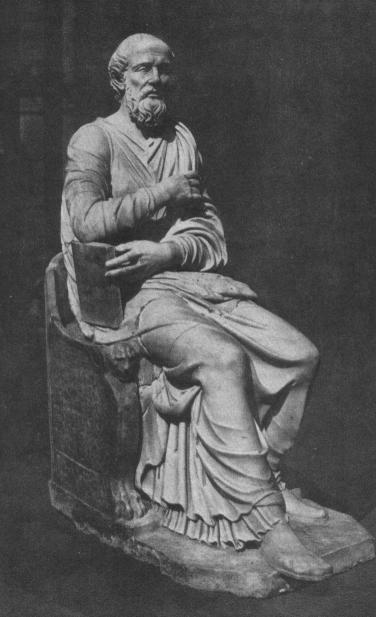
Public domain, via Wikimedia Commons
Hippolytus Statue
I suggest that to clarify when exactly 1 Enoch was shaped into its current form, it is necessary to investigate the sources relating to the origin of the Elchasaites. According to the evidence recorded by Christian theologian, Hippolytus (d. 235 CE)67, in his Refutation of All Heresies, in 222 CE, the last year of Pope Calistus, a Jew named Alcibiades from Apamea came to Rome promising a new remission of sins. He brought with him a Book of Revelation given to the Prophet Elchasai (“hidden power” in Aramaic) by an Angel of huge proportions who had transmitted to him the knowledge of the “mysteries of the world”: “The doctrine of this Calistus having been reported abroad throughout the entire world, a cunning man, and full of desperation, one called Alcibiades, dwelling in Apamea, a city of Syria, examined carefully into this business. And considering himself a more formidable character, and more ingenious in such tricks, than Callistus, he repaired to Rome; and he brought some book, alleging that a certain just man, Elchasai, had received this from Serae, a town of Parthia, and that he gave it to one called Sobiai. And the contents of this volume, he alleged, had been revealed by an Angel whose height was 24 schoenoi, which make 96 miles, and whose breadth is 4 schoenoi, and from shoulder to shoulder 6 schoenoi; and the tracks of his feet extend to the length of three and a half schoenoi, which are equal to fourteen miles, while the breadth is one schoenos and a half, and the height half a schoenos. And he alleges that there is a female with him whose measurement, he says, is according to that already mentioned. And he asserts that the male is the Son of God, but that the female is called Holy Spirit. By detailing these prodigies, he imagines that he confounds fools, while at the same time he utters the following sentence: that there was preached unto men a new remission of sins in the third year of Trajan" (9:13. 1-3).
According to the above, the Revelation of Elchasai occurred in the “third year of Trajan”, and assuming this is referring to the reign of Emperor Trajan (98-117), it can be dated to 100 CE. However, as another passage mentions the Roman – Parthian war that took place from 114-17 CE, the “third year of the Trajanic war” would be 116 CE; this is why Gerhard Littikhuizen decided that the Book of Revelation was composed in 11686. This would set the time of its writing at the beginning of the Great Jewish Diaspora Revolt, also known as the “Kitos War”. Regarding the book that Alcibiades possessed, I would like to suggest that the Revelation is identical to 1 Enoch that included the Similitudes of Enoch, which is missing from the Scrolls. The reference by Hippolytus suggests its composition c. 116 CE; furthermore, this date corresponds to the historical allusions in the Similitudes of Enoch 56 and, according to John Hindley, these fit in better with the events of the Roman-Parthian war in 114-16 CE66. It is significant that not a single reference to 1 Enoch is found in the Hellenistic or early Roman literature and the earliest citation from 1 Enoch 1:9 is found in the Epistle of Jude 1:14-15 from the New Testament, dated within the first quarter of the 2nd century CE, thus indicating that 1 Enoch was recognized by the Christians as a part of the Scripture.
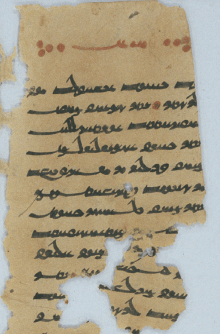
Detail of K20 © Berlin-Brandenburgischen Akademie der Wissenschaften zu Berlin.
Mani's Book of Giants in Sogdian
Furthermore, it seems that the messianic concept of “Son of Man” could only appear in the Similitudes of Enoch (Enoch 48) during the period after the hurban, as a polemical response to the Christian messianic concept of the “Son of God”56. I believe that the apocalyptic ideas contained in 1 Enoch cannot be compared with those of the Hellenistic Jewish messianic literature, as was previously suggested, but should, instead be compared with similar apocalyptic texts contained in the literature of the New Testament, such as the Revelation to John and 2 Esdras; it follows that the main edition of 1 Enoch was composed after the hurban , in the late-1st century, when Dositheus was regarded as Messiah of Aaron by his pupils. In my opinion, the initial composition of 1 Enoch, including the chapters with the Book of the Watchers, and the Book of Giants, can be dated from around 70s-80s, while its final edition, including the Similitudes of Enoch, was issued c. 116 CE.

Public domain, via Wikimedia Commons
Greek manuscript of 1 Enoch
The story of 1 Enoch was continued in 2 Enoch, a book that is absent from the Scrolls and was previously known only in its Slavonic translation; recently, however, some Coptic fragments in Greek were found in Egypt110. Linguistic and textual analysis of this book suggests that it was written in the Greek language and that it was initially composed in sectarian circles, since it reconfirms the validity of sacrifices in the land of Ahuzan which is, most certainly, not Jerusalem. This place can be identified as Mahoza (Zoar) – the large Jewish settlement that arose to the south-east of the Dead Sea during the 2nd to 7th century CE period. It suggests that the sectarian Jewish groups in the Late-Antique period not only preserved the existing body of the Enochic literature, but that they also wrote new books that became part of the Enochic tradition. Later, the Short Version of this book was extensively reworked in the Christian circles into the Longer Version.
Yet, 3 Enoch, another offshoot of the Enochic tradition reappeared among Jewish mystical circles during Late Antique times and the early medieval period119. This book has only survived in Hebrew and became known as Sefer Hekhalot, the “Book of the Palaces”; it develops the story of the ascension of Enoch into Heaven and continues with the miraculous transformation of Enoch into the all-mighty Angel, Metatron109. Being one of the most recognized books of Merkabah mysticism, it found its way into the early Kabbalistic tradition and was later extensively cited by the Book of Zohar. Interestingly, this book was later ascribed, by the rabbinic tradition, to R. Ishmael b. Elisha, one of the influential rabbis of Yavneh, who could not have been a proponent of Enochic ideas. It should be noted that the huge dimensions of the Angel referenced by Hippolytus were not known in the tradition of 1 Enoch, they do appear in 3 Hebrew Enoch; thus, the fact that Alcibiades was familiar with this text is confirmation of the 3rd century CE date for the initial composition for 3 Enoch first proposed by Hugo Odeberg108.
A similar literary tradition was developed among Baptist Judeo-Christian groups living close to the northern shores of the Dead Sea; in addition to 1 Enoch, their library included Pseudepigrapha that have survived in their Greek translation, such as the Testaments of the Twelve Patriarchs85,87. Epiphanius, the Bishop of Salamis in Cyprus who had lived in Palestine until 362, recorded in his book, the Panarion38, written c. 375 CE, information concerning the specific beliefs and practices of the followers of Elchasai, who lived to the north-east of the Dead Sea (53, 1, 1-2). He claimed that the Sampseans derived from the Jewish sect of Osseans, who were exposed to the teachings of Elchasai (19, 2, 2). This remark reveals the only connection of the literary heritage of the Essenes, to the Scrolls.
According to Hippolytus, the Book of Elchasai was introduced to the “one called Sobiai”, whose identity is of considerable importance. It is quite feasible that it is a reference to the same group who lived in Harran, in Upper Mesopotamia, who became known as the Sabi’ah (literally, “baptized”), and were recognized in the Qur’an as a People of the Book along with the Jews and the Christians (19:56-57; 21:85-86). According to Erder, the Sabi’ah considered Enoch as their Prophet, which explains the respectful Qur’anic references to the Prophet Idris, who was regarded as a “Righteous man”41. This is probably why, in the Arabic tradition, Idris was identical to Enoch, who was blended with the Qumranic figure of the Interpreter of the Torah ( darshan ha-Torah), hence the possible derivation of the Arabic name, “Idris”. Citing evidence from the patristic literature, Daniel Chwolson suggested that the Sabi’ah originally evolved from the sect of Elchasaites26, which implies that the Sobiai of Alcibiades can be identified as the Elchasaites of Upper Mesopotamia. It must also be taken into account that when Hippolytus reported that Elchasai found his book in Serae, in Parthia, it is possible that he was referring to the Parthian Kingdom of Adiabene, located in Upper Mesopotamia, whose kings had converted to the Jewish religion around 30 CE90. Since Alcibiades was acquainted with the Revelation of Elchasai, this encourages a reassessment regarding the continuing spread of Enochic beliefs, which were apparently popular among the Jews of Adiabene. The rabbinical tradition of the Late Antique period recorded in the Babylonian Talmud, repeatedly referring to their opponents as the “Zadokim”, however, identifying their precise location remains one of the crucial issues in current research into the fate of the Zadokites. The discoveries made by Michael Stone on the spread of literature related to the Apocrypha and Pseudepigrapha of Qumran in the medieval Armenian literature137, suggest that a significant proportion of the Upper Mesopotamian Jews during the Late Antique and medieval period remained devotees of the Zadokite teachings.
Importantly, the Manicheans, a sect founded in the 240s CE by the Prophet Mani (c. 216-74 CE), was the only non-Jewish religious movement, apart from the Ethiopian Christians, to hold the Enochic literature in high regard. An analysis of Mani’s works shows that his teachings were inspired by 1 Enoch which he frequently referenced in his book144. Among the books related to the Enochic circle, it is only the Giants that was ascribed to Mani becoming an integral part of the Manichean canon118. Its popularity spread as the Manicheans moved eastwards, along the Silk Road, and various fragments of the text were discovered in the Turfan collection of manuscripts, while the earliest fragments of this book were found among the Scrolls, implying that the Manicheans might have had access to the literature of Qumran138. Mani’s biography, preserved in the so-called Cologne Codex, recounts how the future Prophet had grown up in an ascetic Jewish sect in Mesopotamia. This hagiographic account of Mani’s youth contains descriptions of the customs and rituals practiced in his childhood community that conform with known practices of the Elchasaites. Central to the tenets of this sect were the rules governing the ritual purity of the body that involved constant bathing and ritual cleansing. Mani’s rejection of these practices resulted in his being accused of opposing the commandments of the “Saviour” (Elchasai), and he was brought before the court of the Sanhedrin. He attempted to justify himself by invoking stories relating to Elchasai, regarding himself as his true follower78. However, the leaders of the community did not accept his arguments, and Mani was expelled. The Elchasaite character of the sect where the future Prophet grew up, explains why the Manicheans, who usually held a negative attitude towards the rabbis, would pay so much attention to 1 Enoch, a Jewish apocalyptical book73.
Comparing the information contained in Cologne Codex with the Covenant, John Reeves pointed to some convincing parallels concerning the form of internal governance and community structure between the sect of Qumran and the Elchasaites; he highlighted certain similarities that can be seen in the use of the social terminology, especially with regard to the positions occupied by the sectarian leadership. He referred to the striking parallels between the Hebrew terms used in the Covenant and the Greek terms used in the Codex to designate different offices, examples of which include: the “master of the house” (mevakker) – “the inspector who oversees all the camps”; the “elders of the law-court” – the zkenim of Sanhedrin; the “seats in the session of the court” (mushav ha-rabbim) – the Elchasaite’s Sanhedrin, an “Assembly”115. These observations allow us to consider the possibility of a common origin of the Elchasaites and the Zadokites.
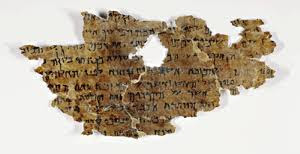
Photo courtesy of N.C. Museum of Natural Sciences
Jubilees fragment from Qumran
The idea of the solar calendar, first proposed in 1 Enoch, was developed later in another important Pseudepigrapha related to the Scrolls of Qumran – the Jubilees. This book claims to present "The History of the Division of the Days of the Law…and the Jubilees of the World" that was revealed to Moses by an Angel. It is the only book to which the Covenant explicitly refers to by its name – as the Book of Divisions of Times – and considered as authority on matters relating to the calendar (CD XVI, 2:4). In fact, it re-writes the history of the events recorded in the Torah in terms of divisions of time, jubilees, each division being 49 years in length72. It explicitly mentions the figure of Patriarch Enoch, crediting him with establishing the solar calendar and preserving a “testimony that recounted the weeks of the jubilees and made known the days of the years” (4:17-18). It also contains a reference to the Book of the Watchers, where Enoch is presented as the person to have invented the offering of sacrifices, having been instructed by God to “burn the incense of the sanctuary” (4:22-25). While attempting to create a synthesis between the ancient Mosaic and innovative Enochic traditions, it reveals some otherwise unknown Mosaic laws, such as the strict rules relating to the Shabbat133.
Early research indicates a 1st century or early-2nd century CE date for the Jubilees, which was thought to have been written in response to early Christian propaganda. In 1856 Bernhard Beer compared the Jubilees with rabbinic literature but concluded that the legal material contained in the Jubilees differed significantly from rabbinic Halakha10. Arguing that the Biblical portions of Jubilees were based on the Samaritan Pentateuch rather then Masoretic text, he concluded that Jubilees were written by a member of the Samaritan Dosithean sect in Egypt. However, following the discovery of the Scrolls in Qumran in 1947, where about fifteen different Jubilees fragments were found, all in Hebrew, it was concluded that Jubilees was originally composed in Hebrew in the sectarian circles of Judea. During later research, scholarly consensus resolved that the composition of the Jubilees should be dated to the late Hellenistic/early Maccabean period, with many different dates having been proposed from around 160 to 120 BCE53,133,143. It appears, however, that the text itself does not contain any references that would corroborate such a date. Instead, it refers to the “times of troubles”, when the Jews were being “scattered among the nations” and expresses sincere hopes that Jerusalem would soon become the Center of the World. These references were unlikely to be relevant for the Jews of the late Hellenistic period, when most of the Jewish population was living in the Land of Israel, and the Second Temple’s cult that includes sacrificial offerings was particularly prosperous.
Furthermore, Jubilees indirectly provides chronological indications by praising the military actions of the “Sons of Jacob” against the “Sons of Esau” (37:1-25), and relating to the victory of the Sons of Jacob on the “Mount of Seir” (38:9-10), with the result that the Sons of Jacob settled there, and the Sons of Esau became their “slaves”. As the Biblical name of the Mount of Seir was usually applied to the mountainous range in south-west Transjordan, this reference cannot be related to the Maccabean victory over the Idumeans because they never enjoyed a victory there. The military encounters between the “Sons of Jacob” and the “Sons of Esau” can be explained, however, if Jubilees referring to the Jewish - Nabatean military confrontation and the triumph of the Jews in the beginning of the Second Revolt; as a result, the Nabatean territories in south-west Transjordan were included in the state of Bar Kokhba30. Documents from the Babatha archive provide evidence that the Jews started settling in the city of Mahoza, to the south-east of the Dead Sea, shortly before 120 CE31. Among over hundred Aramaic Jewish tombstones that were discovered in recent decades in illegal excavations on the site of Zoar (Mahoza), some were found to bear a dating according to the “destruction of the House of Israel”12,102; similar dating, which was found on one of the documents originating from the Cave of Letters, refers to the “Fourth year of the destruction of the House of Israel”, corresponding to the failure of the Second Revolt20.
In addition, Jubilees 30 extended the Biblical story of the “abduction and rape of Dinah, daughter of Jacob” by Shechem, the son of Hamor, and suggested that blame should be placed on all the “people of Shechem”, who were considered to be collectively responsible for this event. The unfavorable remarks in Jubilees could be a negative response to Dositheus’ hostile treatment by the Shechemites. Another chronological indication is the awareness of nudity in Jubilees 3 and the attention to the particular importance of the rite of circumcision, which was forbidden by the Roman authorities; a statement showing it as a reason for the Revolt found in the Historia Augusta corresponds to the Talmudic reference to its priority in “times of danger” that was underlined by R. Eliezer (Sh. 7; 130a) 113,126. In the light of the above evidence, Hellenistic date for the Jubilees should now be reconsidered. Taken into account its similarity to the Temple Scroll and that it was not known until the late-Roman period, when it was firstly referenced in the 4th century by Epiphanius, it can be inferred that it was authored by R. Eliezer b. Hyrcanus around 117/8 CE; at the time, the memories of Jewish victories over the Nabateans on the eve of the Second Revolt were still fresh, and there was the beginning of a Jewish Diaspora in the region to the south-east of the Dead Sea.
7. The Aftermath of the Scrolls and the Fate of the Zadokites in the Diaspora
Since the Scrolls do not contain any materials on events following the death of Hadrian in July 138 CE, it suggests that they were hidden in the Caves of Qumran sometime before that date, and following the period of the Roman persecutions. The Zadokite movement, however, did not cease to exist after Hadrian, but it seems that its popularity during the later period was mainly attached to the history of Samaritan sectarianism. The Samaritans actively participated in the Second Revolt in the beginning of the uprising, and this can be confirmed by the multiple finds of rebels’ coins that have been unearthed in the Samaritan territory99. Evidence from the Samaritan chronicles confirms their negative attitude towards Hadrian, who they blamed for forbidding the Samaritans to proselytize, to be circumcised, and to observe Shabbat; following Hadrian’s visit, the Samaritans used fire to purify all the places he had visited19. Although rabbinic sources referred to Bar Kokhba’s especially harsh treatment of the Samaritans who were accused of his betrayal to the enemy during the siege of Beitar (Lam. Rab. II, 2, 4), it seems possible that this was a reference to the Zadokim of Samaritan origin who joined the rebels at the beginning of the Revolt but later abandoned them. As a result, the fate of the Judeans and the Samaritans because of the tragic failure of the Second Revolt were very different and their destinies finally partied ways112.
In his Syntagma written around 230 CE, one of the Church fathers, Hippolytus, noted that the “Sadducees” were especially numerous in Samaria. If this statement is true, it would point to the rising popularity of the Zadokite beliefs among the Samaritans during the time of the Samaritan High Priest Baba Rabba, who flourished c. 217-245. A Christian theologian, Origen from Alexandria (c. 184-253), who lived and preached in Caesarea in the 230s CE, referred to Dositheus as an important messianic figure, and mentioned that his disciples possessed books composed by him and regarded him as the Son of God, who “never suffered death but was still alive” (Against Celsus I. 57; VI. 2). The significant rise in popularity of Dositheus’ ideas among the Samaritans was probably as a result of the discovery of the Scrolls that was as well reported by Origen on another occasion as happened during the time of Emperor Caracalla, who died in 217 CE. This discovery may be related to the actions of Levi, a nephew of Baba Rabba. Abu'l-Fath told how Levi went to the place where Dositheus was hiding and obtained access to his works19. Upon his return to Shechem, Levi attempted to convince the Samaritans to accept Dositheus’s teachings, but was stones to death.
It is difficult to assess the extent of Dosithean influence on Samaritan sectarianism during medieval times, and also the reasons behind the exceptional popularity of Dositheus’ ideas among different groups of the Samaritan Diaspora. The continuing presence of the Dositheans in Egypt, right up until the 12th century, that was commented on by many Christian and Muslim authors70, might possibly explain the access of the Karaites in Egypt to the Zadokite literature, as evidenced from the documents of the Cairo Genizah. Indeed, in the 6th century, Patriarch Eulogius of Alexandria, wrote harshly about against the “followers of Dostan”, demonstrating that the Dositheans exercised a certain degree of power in Egypt at the time, and were numerous enough to induce Eulogius to engage in polemics against them. Al-Masudi, the famous 10th century Arab historian, considered the followers of Dostan to have a great influence among the Samaritans as they “believed in the eternity of the world”. The 12th century Persian historian al-Shahrastani also referred to Dusitaniyyah, whose leader al-Ilfan, the “Teacher”, claimed to be “the one Moses had foretold”, and was the “star shining from the light of the moon”; this characteristic corresponded closely to the messianic concept of the Damascus Covenant, which was focused on the idea of the “Star”.
Although the Scrolls were first discovered in the 210s CE, it was only after another discovery was made in the late 8th century CE that the Jewish sages began to take special interest in the literary traditions of Qumran. Shortly before 800, as attested by a letter written by the Nestorian Patriarch Timotheus I from Damascus, to Sergius, Metropolitan of Elam, “hundreds of books of the Bible and the Psalms” were discovered “in a cave near Jericho”. A similar tradition was referred to by al-Qirqisani in the story of Magariyya, whose books were reported to have been discovered in a cave. Additionally, the 10th-century Spanish Jew, R. Hasdai ibn Shaprut, in his letter to the Khazar qagan Joseph, reported on the discovery of books in a “secret cave”, where they had been hidden in the days of persecutions. It is possible that the rediscovered Scrolls could have included examples of sectarian books composed by the Zadokites. In this respect, the discoveries made among the manuscripts in the medieval Cairo Genizah, are particularly notable; except the two large copies of the Damascus Covenant, this important collection included many books of the Apocrypha, such as Ben Sirach, as well as sectarian writings, such as the Jubilees, and the Testament of Levi. This discovery indicates a possible connection between the Zadokite tradition and the origin of the early Karaite movement and may be especially relevant in the light of accusations brought by medieval rabbis concerning the “Zadokite” identity of the Karaites.
It was shown by Yoram Erder that many ideas contained in the Scrolls were borrowed by the early Karaite exegetes, an example of which is the dualistic messianic concept of Daniel al-Qumisi42. This does not mean, however, that the two sects can be equated since, as has been shown by Haggai Ben-Shammai, the Halakha of Qumran was not of any practical use among the Karaites who maintained a different practices, such as allowing divorce and denying sacrifices. Additionally, it must be noted that the majority of the Karaites employed a lunar calendar as opposed to the solar calendar that was used by the sectarians of Qumran. It was not only the Karaites, who borrowed extensively from the Scrolls of Qumran, but also the works of some European rabbis reveals their familiarity with the Testament of Levi, and Naphtali; additionally, the 9th-century Midrashic work,Pirkei de-Rabbi Eliezer, was particularly influenced by the Jubilees136. This would suggest that they also must have had access to the rediscovered Scrolls.
Another possibility that should be considered is that Zadokite traditions may have continued to be observed by different sectarian groups of Jewish identity who survived in the Diaspora; indeed, the Apocrypha and Pseudepigrapha, which were written or adopted by the sect of Qumran, may have been preserved, copied, and then rewritten in medieval times by various sectarian groups akin to the Zadokites. A possible connection can be observed between the expansion of the Zadokite movement and the origin of the Jewish beliefs in Yemen and Ethiopia. Already in his publication of the Damascus Covenant, the “Zadokite Fragments”127, Solomon Schechter noted that the rules observed by the Covenanters concerning Shabbat, as well as those relating to ritual purity, were similar to the ones followed by the Ethiopian Jews, Beta Israel, who had access to the Jubilees; in his opinion, it explains why throughout the centuries they had observed the Zadokite Halakha. Recently, the study of the religious practices of Beta Israel – not only their strict regulations for Shabbat rest but also many of their holiday practices – reconfirmed that they were almost identical to those observed by the sectarians of Qumran. Kohler, however, objected to Schechter’s proposal as he realized that the religious orientation of the Ethiopian Jews towards Jerusalem, as laid out in the Jubilees, contradicted his own theory on the Samaritan origin of the Zadokite Jews79. However, this contradiction can be resolved if we consider that Dositheus himself was a Jew, who disagreed with the Samaritan cult in Shechem, and his followers decreed that until proper sacrificial rituals could be restored in the future Temple in Jerusalem, they could be performed elsewhere, such as in the Land of Zawila19, which can be identified as the Biblical Land of Havilah, located in Yemen.
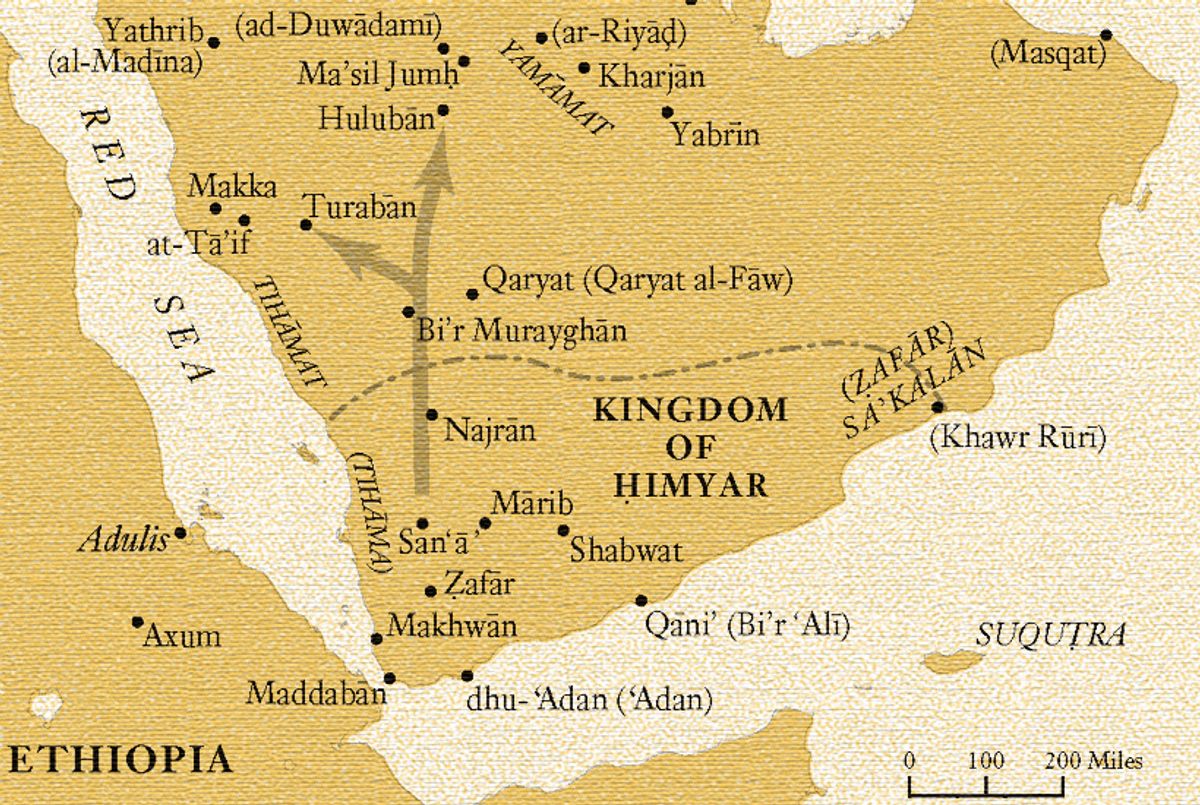
Late Antique Southwest Arabia, map based on I. Gadja, Le royaume de Himyar à l’époque monothéiste (Paris, 2009), p. 139.(Courtesy of Oxford University Press)
map - Himyar
It seems that while the Covenanters expressed some concerns about proselytism, the Zadokites might have adopted a different approach during the later period. Already in the early-5th century CE, the rulers of the Kingdom of Himyar that flourished in the area that is today south-west Yemen accepted the Jewish religion, with the result that the majority of the population also converted. The fact that the existence of the Jewish Kingdom of Himyar was entirely ignored by the rabbis of Babylonian Talmud would suggest that the local Jewish beliefs were probably significantly different from those practiced by the rabbinical Jews of Babylonia. The Kingdom of Himyar was destroyed in 525 CE by the King of Aksum, and many prisoners were taken to Ethiopia; this might explain the origin of the Jewish beliefs in Ethiopia as well as their access to the Pseudepigrapha related to the Zadokite tradition that had probably previously spread in the Kingdom of Himyar. Recently Jan van Reeth argued that the Jubilees had great influence on the formation of Islam, sharing an identical concept of revelation, whereby God’s words and commandments were eternally written on celestial tablets, and an angel revealed their content to a prophet; in addition, he also compared Abraham’s role in the Jubilees and in the Qur’an114. His observations are particularly interesting in comparison to the story showing how the Judaism in Himyar was introduced by the Jewish traders of Medina, with whom Muhammad later closely interacted84.
Additional information on the subject emerges from the writings related to Eldad Ha-Dani, an enigmatic Jewish traveler of unknown origin who visited many Jewish communities in the Mediterranean region during the 880s; he recounted fascinating stories of the whereabouts of the “Lost Tribes of Israel”, and reported that he belonged to the “Tribe of Dan”, one of the four tribes that independently dwelt in the “Land of Havilah”, located on the other side of the “River of Kush”. This land has often been identified by scholars as Ethiopia, but Shlomo Morag’s analysis of the Hebrew language used by Eldad101 shows that it did not contain any traces of the Ge’ez that was spoken by the Jews of Ethiopia, but instead, resembled the dialect spoken by the Jews of Najran, an important trading city located on the Saudi border with Yemen. Therefore, the halakhot of shechita, and other unusual laws reported by Eldad on the authority of Joshua bin Nun, which were quite different from both the Rabbinic and Karaite Halakha, may reflect the old Zadokite traditions that were preserved amongst the Jews of South Arabia. Considering that the spread of the Zadokite ideas was particularly significant among the Samaritans, the identity of the “Lost Tribes of Israel”, which Eldad applied to his brethren living in Arabia, may indicate their Samaritan affiliation.
The Zadokite tradition apparently reached the northern shores of the Black Sea, when Jewish beliefs spread among the Khazars during the 8th -11th centuries through the intermediary of the old Jewish communities of Taman' and Crimea53. According to information preserved by the 4th century Christian authority, St. Jerome, who relied on unknown Jewish sources, the earliest Jewish settlers living in the Greek Kingdom of Bosporus, were descended from the Jews who were exiled there by Hadrian; these communities flourished in the areas to the north of the Black Sea and to the east of the Sea of Azov up until around the 12th century. The Slavonic Vito of St. Cyril tells that he studied the Hebrew language, when visiting the city of Khersones in western Crimea in 860, and reported on his close interactions with the Samaritan Jews. As the patristic literature often identified Samaritan sectarians as the Zadokites, this is probably why St. Cyril, who was well acquainted with this tradition, referred to the Zadokite Jews as Samaritans. The copy of the Khazar Qagan Joseph’s Letter to R. Hasdai ibn Shaprut, which was made available c. 1100 to the Spanish Jew, Ibn Barzillai, tells of the building of a Tabernacle following the Khazar qagan’s conversion, and Ibn Barzillai made a deliberate reference to the offering sacrifices practiced by the Khazar Jews81.
R. Petachiah from Regensburg, who visited Eastern Crimea soon after the fall of the Khazar Qaganate, around 1185, observed that the remnants of the Khazar Jews preserved non-rabbinical practices, while strictly respecting the rules of the Shabbat rest, they stayed all day in their homes. R. Petachiah referred to these Jews as minim, in exactly the same manner that the Talmud referred to Zadokim. The letter of Hasdai, as well as the Cambridge Anonym, written by a Khazar Jew, contain references to the discovery of books in a cave that played a special role in the process of the Khazar kings’ conversion; this story probably relates to the discovery of the Scrolls that was made known to Timotheus. It seems that, because of the activities of the Radhanites, the international Jewish traders who reached Khazaria around 800111, the Khazars had obtained access to the Scrolls. Following the destruction of the Khazar Qaganate by the Rus', the books related to this sectarian tradition were spread within the borders of the Old Rus' Qaganate, thus quickly becoming an integral part of the Christian culture of the Old Rus'. The Nachalnaja Letopis, the oldest part of the Old Rus' Chronicle, Povest Vremennyh Let, includes a few citations borrowed from 1 Enoch and Jubilees, which suggests that these books, in Old Slavonic translation, were introduced to the Old Rus' scribes by local Jews. All these various pieces of evidence point to the Zadokite character of the religious beliefs spread among the Jews of Khazaria.
8. Conclusion
The current paper proposes a new dating for the Scrolls and also puts forward a suggestion as to the identity of the sect of Qumran who were responsible for their compilation. I suggest that the members of the sect were part of a group that become known in the Mishnah as minim, or Zadokim; they opposed to the rabbis and flourished during the period following the destruction of the Temple and until the end of the Bar Kokhba Revolt. The movement of the Zadokites was probably founded by a group of Sadducean priests, who flew from Jerusalem to Damascus in 70 CE, and were later influenced by the Samaritans and Gnostics. Apart from the Biblical Scrolls and some old Apocrypha such as Ben Sirach, that probably belonged to the exiled Sadducean priests, the library of Qumran consisted of books ascribed to different stages in the development of the sectarians’ ideas.
The earliest stage was related to the figure of Prophet Dositheus, who after 70 CE replaced Shimon Magus – a famous Samaritan magician, and a Gnostic leader, who fought against the Apostles around 50 CE. Since Dositheus claimed to have obtained the Knowledge of the Secrets of the World, this would make him a likely candidate for the role of Zadok who was regarded by the sectarians to have been the first person, to whom the “Hidden Book of Law” has been revealed. This, in my opinion, is a reference to 1 Enoch – one of the most important Apocrypha deriving from the library of Qumran. The concept of the revelation of the “Hidden Knowledge” suggests that Dositheus probably created the ancient tradition of the so-called “Enochic Judaism”, as it was named by Gabriele Bocaccini13,14,15,16, and he appeared to be the author of the so-called Enochic Pentateuch of Qumran. If we accept that Dositheus, who was named, in Hebrew, Zadok – “Righteous” – is identical to Elchasai (“Hidden Power”, in Aramaic), this would not only allow the Dositheans to be identified as the early Zadokites, but also as the Elchasaites. After Dositheus’ death, his followers, while attaching to him their messianic expectations, anticipated that he would be resurrected soon, as the Messiah of Aaron and Israel32. According to the Covenant, during the later period of the sectarians history, they were led by a follower of Dositheus, who became known as *yoreh yahad – the “Teacher of the Community”, and who, in my opinion, can be identified as the Samaritan sage, Yahdu. He was an ascetic who was probably responsible for the significant Samaritan influence on the early Zadokite ideology as was revealed in the Community Rule - Serekh Ha-Yahad. It can be suggested that the title of this important sectarian document might have preserved his name.
The next stage can be ascribed to R. Eliezer b. Hyrcanus – the sectarian leader, who was known as the Teacher of Righteousness, or the Interpreter of Knowledge. As a result of the decision of R. Gamliel II, the head of the Sanhedrin of Yavneh, he was excommunicated from the community of Judea and become the leader of the sectarians in Damascus; having invented the concept of a New Covenant, he brought them back to Judea in the beginning of Hadrian’s reign, in the late-117. He was a representative of the conservative school of Shammai, which insisted on a more rigorous approach to Halakha, and was opposed to the rabbis’ Halakha based on the principles of Hillel that was accepted by the Sanhedrin of Yavneh. Importantly, all the books composed by R. Eliezer were written in Hebrew, the language that had fallen into disuse during the Second Temple period but which became popular again as the symbol of national revival on the eve of the Second Revolt. Apart from the Jubilees that attempted to present an alternative to the rising popularity of Christianity by reconciling the Enochic ideas with old Mosaic laws, it is likely that Eliezer authored the Temple Scroll, the Thanksgiving Psalms, the laws of the Damascus Covenant, and the Halakhic Letter. Apparently, due to his efforts, the peaceful ascetic priestly community of Yahad was transformed into the militaristic movement of the Damascus Covenanters; their eschatological messianic hopes were meant to be realized when the initial success of the Great Diaspora Revolt gave hope for the liberation of the Jews from the Roman rule.
At the beginning of the Second Revolt, when R. Eliezer led the rebels, he positioned himself as a High Priest, and initiated the construction of the Third Temple, a project described in details in the Temple Scroll. At the time, the Covenanters invented a messianic concept of a dual messianism: one of the messianic figures was associated with the “Star” – the priestly figure, who was identified as Eliezer, and another, who was a secular and a military leader – with the “Scepter”, by whom they probably meant Bar Kokhba, who was supported by R. Akiva. However, the sharp differences between the two leaders on matters of ritual purity and the calendar meant that Eliezer was removed from his position in the middle of the Revolt. His efforts were later continued by Bar Kokhba, who created an independent state that lasted for a period of two and a half years’ time, until his loyal supporters were besieged and destroyed in the fortress of Beitar. As it became abundantly clear that his heroic attempt to obtain independence from Roman rule had failed, the sectarians blamed Shimon for the failure; they started calling him the Man of Lies, and claimed that he and his supporters, the “traitors”, had brought these troubles upon themselves for not complying with their demands.
The connection between the Zadokites, who possessed the Scrolls of Qumran, and the population of the Settlement in Khirbet Qumran, remains questionable. Golb argued against its possible connection with the Caves of Qumran because the Settlement appears to be a military site unsuitable for an ascetic community89. It is possible that the supporters of the Second Revolt were the last occupants of this site, which would explain its military character; this would suggest that the sectarians, who arrived from Damascus to Judea in 117, took part in the Second Revolt in 118/9 when it was led by Eliezer; after their leader was removed from power, they retired to Khirbet Qumran. It seems that some of the latest Scrolls were written around the time of the failed Second Revolt, when the anonymous author of the Pesharim, probably the same person otherwise known as mevakker – the “Inspector of the Camp”, analyzed the situation pertaining in its aftermath. The same person probably issued a final edition of the Covenant; the terminus post quem for its final composition can be established by reference to the forty-years-period that passed after the death of Yahdu and before the failure of the Man of Lies and his supporters, the Men of War; they might be identified as Bar Kokhba and his followers. A reference to Hadrian as the “Head over the Greek kings”, who will “wreak vengeance on the dragon nations” (CD XIX, 23-24), also suggest that it was written after 131/2, when the idea of Panhellion was announced.
During the late-Antique period, many sectarian movements, both Jewish and non-Jewish, created their own literary traditions, closely related to the Apocrypha and Pseudepigrapha found among the Scrolls of Qumran; the ideas borrowed from 1 Enoch and the Jubilees were adapted not only by the Samaritan Dositheans, but also by the Elchasaites, Manicheans, Kabbalists, Muslims, and Judeo-Christians. Although the Scrolls were hidden in the Caves of Qumran sometime around 138 CE, their subsequent occasional discoveries, firstly, in the early-3rd century CE, and secondly, in the late-8th century CE, long before the final discovery of the Scrolls in 1947, could have led to the renewed interest in the Apocrypha and Pseudepigrapha literature of Qumran amongst various Jewish groups in Diaspora. The first discovery led to the spread of Zadokite ideas among the Samaritans; and as a result of the second find, some of the Scrolls were studied and extensively reworked by the Karaites sages, and were also accessed by some European rabbis. The ensuing spread of the Zadokite ideas within the medieval Jewish Diaspora was facilitated by the extensive missionary proselytizing efforts of the Radhanites Jewish traders; in turn these led many of the ruling elites of remote gentile nations to convert to Judaism, such as the Himyarite, the Ethiopians, and the Khazars.
Selected Literature
- 1. M. Albany et al., eds: Studies in the Book of Jubilees. Tübingen, 1997.
- 2. J. M. Allegro: The Dead Sea Scrolls. London – Melbourne – Baltimore, 1956.
- 3. E. Almagor: Jerusalem and the Bar Kokhba Revolt Again: A Note. In: Electrum, Vol. 26, 2019, p. 141–157.
- 4. F. Astren: The Dead Sea Scrolls and Medieval Jewish Studies: Methods and Problems. In: Dead Sea Discoveries, Vol. 8, No. 2, Qumran and Rabbinic Judaism, 2001, p. 105-123.
- 5. J. Atwill, S. Braunheim, and R. Eisenman: Redating the Radiocarbon Dating of the Dead Sea Scrolls. In: Dead Sea Discoveries, vol. 11, 2, 2004, p. 143–157.
- 6. R. D. Aus: Luke 15:11-32 and R. Eliezer Ben Hyrcanus's Rise to Fame. In: Journal of Biblical Literature, Vol. 104, No. 3, 1985, p. 443-469.
- 7. J. Baer: The Manuel of Discipline. A Jewish-Christian Document from the Beginning of the Second Century C. E. In: Zion, vol. 29, 1964, p. 1-60 (In Hebrew).
- 8. D. Barag: The Effects of the Tennes Rebellion in Palestine. In: BASOR, vol. 183, 1966, p. 6-12.
- 9. J. B. Baumgarten, E. G. Chason and A. Pinnick: The Damascus Document: A Centennial of Discovery. Leiden – Boston – Köln, 2000.
- 10. B. Beer: Das Buch der Jubiläen und sein Verhältniss zu den Midraschim: ein Beitrag zur orientalischen Sagen- und Alterthumskunde . Leipzig, 1856.
- 11. A. R. Birley. Hadrian. The Restless Emperor. London – New York, 1997.
- 12. J. Bitton, N. Dweck, and S. Fine: Yet Another Jewish Tombstone from Late Antique Zoar/Zoora: The Funerary Marker of Hannah Daughter of Levi. In: Puzzling Out the Past. Studies in Northwest Semitic Languages and Literatures in Honor of Bruce Zuckerman. 2012, p. 7-12.
- 13. G. Bocaccini, ed: The Origins of Enochic Judaism. Turin, 2002.
- 14. Ibid, ed.: Enoch and Qumran Origins: New Light on a Forgotten Connection. Grand Rapids: Eerdmans, 2005.
- 15. Ibid, ed.: Enoch and the Messiah, Son of Man: Revisiting the Book of Parables. Cambridge, 2007.
- 16. G. Boccacini and G. Ibba, eds: Enoch and the Mosaic Torah. Grand Rapids. Michigan, 2009.
- 17. Y. Bourgel: Jewish Christians and other Religious groups in Judea from the Great Revolt to the Bar-Kokhba War . Tel Aviv, 2009.
- 18. J. Bowman: Is the Samaritan Calendar the Old Zadokite One? In: Palestine Exploration Quarterly, vol. 91, 1959, p. 23-37.
- 19. Ibid: Samaritan Documents relating to their History, Religion and Life. Eugene, Origon, 1977.
- 20. M. Broshi and E. Eshel: 4QHistorical text A. In: Qumran Cave 4, XXVI: Miscellania, part 1, 2000, p. 192-200.
- 21. L. Capponi: Hadrian in Jerusalem and Alexandria in 117. In: Athenaeum, vol. 98, 2010, p. 489-502.
- 22. Cassius Dio. Roman History. Loeb Classical Library, 9 vols, Greek texts and English transl by E. Cary: Harvard University Press, 1914 thru 1927. (https://penelope.uchicago.edu/Thayer/E/Roman/Texts/Cassius_Dio/home.html)
- 23. J. Charlesworth, ed.: The Old Testament Pseudepigrapha . Vol. 1. Apocalyptic Literature and Testaments. New York, 1983. Vol. 2. Expansions of the "Old Testament" and Legends, New York, 1985.
- 24. Ibid, ed: The Dead Sea Scrolls. Vol. 1. Pesharim, other Commentaries, and Related Documents. Vol. 2. Damascus Document, War Scroll, and Related Documents. Tubingen – Louisville, 1995-2002.
- 25. B. Chiesa and W. Lockwood: Ya’qub al-Qirqisani on Jewish Sects and Christianity. Frankfurt am Main – Bern - New York - Nany, 1984.
- 26. D. Chwolson: Die Sabier. St-Petersburg, 1856.
- 27. K. W. Clark: Worship in the Jerusalem Temple after 70 A.D. In: New Testament Studies, vol. 6, 4, 1960, p. 269-280.
- 28. S. J.D. Cohen: The Significance of Yavneh: Pharisees, Rabbis, and the End of Jewish Sectarianism. In: Hebrew Union College Annual, vol. 55, 1984, p. 27-53.
- 29. M. A. Collins: The Use of Sobriquets in the Qumran Dead Sea Scrolls. New York, 2009.
- 30. H. M. Cotton:The Bar Kokhba Revolt and the Documents from the Judean Desert:Nabatean Participation in the Revolt. In: P. Schafer, ed. The Bar Kokhba War Reconsidered. Tübingen, 2003, p. 133-152.
- 31. H. M. Cotton and J. C. Greenfield: Babatha's "Patria": Maḥoza, Maḥoz 'Eglatain and Ẓo'ar. In:Zeitschrift für Papyrologie und Epigraphik, vol. 107, 1995, p. 126-134.
- 32. A. D. Crown: Dositheans, Resurrection and a Messianic Joshua. In: Antichthon, vol. 1, 1967, p. 70-85.
- 33. Ph. R. Davies: 1QM, the War Scroll from Qumran: Its Structure and History. Rome, 1977.
- 34. Ibid: The Damascus Covenant. Sheffield, 1982.
- 35. Ibid: The Judaism(s) of the Damascus Document. In: The Damascus Document: A Centennial of Discovery, ed. by J. Baumgarten, E. Chazon, A. Pinnick. Brill, 2000, p. 27-44.
- 36. G. Doudna: Who is the Lion of Wrath of Pesher Nahum? A Brief Analysis. In: M. Mueller and T. L. Thompson, eds. Historie og konstruktion: Festskrift til Niels Peter Lemche i anledgning af 60 aars foedselsdagen. ( Niels Peter Lemche festschrift ). Copenhagen, 2005, p. 1-19.
- 37. R. Eisenmann: James the Brother of Jesus and the Dead Sea Scrolls I: The Historical James, Paul the Enemy, and Jesus' Brothers as Apostles, 2019, Vols. 1-2.
- 38. Epiphanius. The Panarion. A Treatise Against Eighty Sects in Three Books. Book I. Transl. by F. Williams. 1987-2009.
- 40. Epiphanius' Treatise on Weights and Measures - The Syriac Version, ed. J. E. Dean, University of Chicago Press, 1935.
- 41. Y. Erder: The Origin of the Name Idris in the Qur'an: A Study of the Influence of Qumran Literature on Early Islam. In: Journal of Near Eastern Studies, vol. 49, 1990, p. 339-50.
- 42. Ibid: The Karaite Mourners of Zion and the Qumran Scrolls. Brepols, 2017
- 43. Ibid: Karaites and Sadducees. In: Diversity and Rabbanization, ed. by G. McDowell, et al. University of Cambridge, 2020, p. 153-163.
- 44. E. Eshel, H. Eshel, and A. Yardeni: A Document from “Year 4 of the Destruction of the House of Israel”. Dead Sea Discoveries, vol. 18, 2011, p. 1-28.
- 45. H. Eshel: The Dead Sea Scrolls and the Hasmonean State. Cambridge – Jerusalem, 2008.
- 46. Eusebius. Historia Ecclesiastica, ed. Roy Joseph Deferrari. Eusebius Pamphili Ecclesiastical History. Washington, The Catholic University of America Press, 1969.
- 47. M. Gichon: New Insight into the Bar-Kokhba War and a Reappraisal of Dio Cassius 69.12-13. In: The Jewish Quarterly Review, Vol. 77, 1986, p. 15-43.
- 48. M. Gil: The Creed of Abu ‘Amir. In: Israel Oriental Studies, vol. 12, 1992, p. 9-47.
- 49. Y. Gilat: R. Eliezer ben Hyrcanus: A scholar outcast. Bar-Ilan studies in Near Eastern languages and culture. Bar-Ilan University Press, 1984.
- 50. M. Girardin: Leherut Yerushalayim: The Temple on the Coins of the Bar-Kokhba War. In: Electrum, vol. 26, 2019, p. 159-176.
- 51. N. Golb: Who Wrote the Dead Sea Scrolls? New York, 1995.
- 52. P. Golden: The Conversion of the Khazars to Judaism. In: The World of the Khazars, ed. by P. Golden, H. Ben-Shammai and A. Rona-Tas. Leiden-Boston, p. 123-162.
- 53. J. A. Goldstein: The Date of the Book of Jubilees. In: Proceedings of the American Academy for Jewish Research, vol. 50, 1983, p. 63-86.
- 54. M. Goodman: Trajan and the Origin of the Bar Kokhba War. In: The Bar Kokhba War Reconsidered., ed. P. Schäfer, Tübingen, 2003, p. 23-29.
- 55. J. Greenfield and M. Stone: The Books of Enoch and the Traditions of Enoch. In: Numen , vol. 26, Fasc. 1, 1979, p. 89-103.
- 56. Ibidem: The Enochic Pentateuch and the Date of the Similitudes. In: The Harvard Theological Review, vol. 70, 1977, p. 51-65.
- 57. M. Grey: Jewish Priests and the Social History of Post-70 Palestine. Chapel Hill, 2011.
- 58. I. Gruenwald: Jewish Sources for the Gnostic texts from Nag Hammadi. In: Proceedings of the Sixth World Congress of Jewish Studies, vol. 3, 1997, p. 45-56.
- 59. A. Guttmann: The End of Jewish Sacrificial Cult. In: Hebrew Union College Annual. Vol. 38, 1967, p. 137-148.
- 60. J. Fossum: Sects and Movements. In: The Samaritans, ed. by A. Crown, Tübingen, 1989, p. 293-389.
- 61. D. N. Freedman and K. A. Mathews: The Paleo-Hebrew Leviticus Scroll (11 Qpaleolev). Philadelphia, 1985.
- 62. R. Freund: Secrets of the Cave of Letters. New York, 2004.
- 63. P. B. Hartog: A Hermeneutical Profile of the Pesharim. In: Pesher and Hypomnema: A Comparison of Two Commentary Traditions from the Hellenistic-Roman Period , Brill, 2017, p. 238–292. (Chapter 10).
- 64. Ch. Hempel: The Laws of the Damascus Document: Sources, Tradition, and Redaction . Leiden, 1998.
- 65. Ibid: The Qumran Rule. Texts in Context: Collected Studies. Mohr Siebeck, 2013.
- 66. J. C. Hindley: Towards a Date for the Similitudes of Enoch. An Historical Approach. In: New Testament Studies, vol. 14, 1968, p. 551-65.
- 67. Hippolytus: Refutation of All Heresies. Trans. by J.H. MacMahon. From Ante-Nicene Fathers, Vol. 5. Ed. by A. Roberts, J. Donaldson, and A. C. Coxe. Buffalo, New York, 1886. (See Chapter VIII). Rev. and ed. by K. Knight: http://www.newadvent.org/fathers/0501.htm.
- 68. W. Horbury: Jewish War under Trajan and Hadrian. Cambridge University, 2014.
- 69. B. Isaac and I. Roll: Legio Trajana in Judea. In: Zeitschrift für Papyrologie und Epigraphik, vol. 33, 1979, p. 149-56.
- 70. S. J. Isser: The Dositheans. A Samaritan Sect in Late Antiquity. Leiden, 1976.
- 71. H. R. Jacobus: Balaam’s ‘Star Oracle’ (Num 24:15–19) in the Dead Sea Scrolls and Bar Kokhba. In: The Star of Bethlehem and the Magi, Interdisciplinary Perspectives from Experts on the Ancient Near East, the Greco-Roman World, and Modern Astronomy , vol. 19, 2015, p. 399-429.
- 72. A. Jaubert: Le Calendrier des Jubileés et de la secte de Qumran. In: Vetus Testamentum, vol. 3, 1953, p. 250-264.
-
73. S. F. Jones: The Book of Elchasai in its Relevance for
Manichaean Institutions.
In: Aram, vol. 16, 2004, p. 176 -215. - 74. K. Juntunen: Pharasmanes and the Jazyges. The Date of the two Embassies in Cassius Dio 69.15.2. In: Historia. Zeitschrift für Alte Geschichte, vol. 62, no. 1, 2013, p. 108-128.
- 75. R. Kalmin: Jewish Babylonia Between Persia and Roman Palestine. New York, 2006.
- 76. M. Kartveit and G. Knoppers, eds.: The Bible, Qumran, and the Samaritans. Berlin and Boston, 2018.
- 77. L. J. F. Keppie: Legions and veterans: Roman army papers 1971–2000. Franz Steiner Verlag, 2000. (See: p. 228–229).
- 78. A. F. J. Klijn and G. J. Reinik: Elchasai and Mani. In: Vigliae Christianae, vol. 28, 1974, p. 277-289.
- 79. K. Kohler: Dositheus, the Samaritan Heresiarch, and his Relations to Jewish and Christian Doctrines and Sects. In: The American Journal of Theology, vol. 15, no. 3, 1911, p. 404-435.
- 80. Ibid: The Sadducees. In: The Jewish Encyclopedia. 1901-1906.
- 81. P. K. Kokovcov: Jewish-Khazarian Correspondence of the 10th Century. Leningrad, 1932 (In Hebrew and Russian).
- 82. M.-J. Lagrange: La secte juive de la Nouvelle Alliance au pays de Damas. In: RB, vol. 9, 1912, p. 213-240, 321-360.
- 83. R. Langer: Cursing the Christians? A History of the Birkat haMinim. New York, 2011.
- 84. M. Lecker: The conversion of Ḥimyar to Judaism and the Jewish Banū Hadl of Medina
- In: Die Welt des Orients, vol. 26, 1995, p. 129-136.
- 85. G. P. Littukhuzen: The Revelation of Elchasai: Investigations into the Evidence for a Mesopotamian Jewish Apocalypse of the Second Century and Its Reception by Judeo-Christian Propagandists . Tübingen, 1985.
- 86. Ibid: The Book of Elchasai: a Jewish Apocalypse. In: Aula Orientalis, vol. 5, 1987, p. 101–6.
- 87. P. Luomanen: Recovering Jewish - Christian Sects and Gospels. Leiden - Boston, 2012.
- 88. A. N. Madsen: Melchizedek at Qumran and Nag Hammadi. In: Apocryphal Writings and the Latter-day Saints, ed. C. W. Griggs, 1986.
- 89. J. Magness: Archaeology of Qumran and the Dead Sea Scrolls. Cambridge, 2002.
- 90. M. Marciak: Sophene, Gordyene, and Adiabene. Leiden, Brill, 2017. (See: p. 255–271).
- 91. F. G. Martinez: Qumran and Apocalyptic. Studies on the Aramaic Texts from Qumran. Leiden - New York - Köln, 1992.
- 92. F. G. Martinez: The Dead Sea Scrolls Translated. Leiden - New York - Cologne, 1996.
- 93. Y. Meshorer: Sepphoris and Rome. In: Greek Numismatic and Archaeological Essays in honor of Margaret Thompson , ed. O. Morkholm, N. M. Waggoner. Wetteren, 1979, p. 163-65.
- 94. Ibid: A Treasury of Jewish Coins. Jerusalem, 2001.
- 95. L. Mildenberg: Bar Kokhba Coins and Documents. In:Harvard Studies in Classical Philology, vol. 84, 1980, p. 311-335.
- 96. Ibid: Coinage of the Bar Kokhba war. Aarau, 1984.
- 97. A. Millard: Judith, Tobit, Ahiqar and History. In: New Heaven and New Earth: Prophecy and the Millennium, eds. by P. Harland and R. Hayward, Brill, 1999, p. 195-203.
- 98. G. F. Moore: The Covenanters of Damascus: A Hitherto Unknown Jewish Sect. In: Harward Theological Review, vol. 4, 1911, p. 330-377.
- 99. M. Mor: The Samaritans and Bar-Kokhbah Revolt. In: The Samaritans, ed. by A. D. Crown, Tubingen, 1989, p. 19-31.
- 100. Ibid: The Second Jewish Revolt: The Bar Kokhba War, 132-136 CE. Brill, 2016.
- 101. Sh. Morag. Eldad Haddani’s Hebrew and the Problem of his Provenance. In: Tarbits, vol. 66, 1997, p. 223-246. (In Hebrew).
- 102. J. Naveh: Another Jewish Aramaic Tombstone from Zoar. In: Hebrew Union College Annual vol. 56, 1985, p. 103-116.
- 103. J. Neusner. Eliezer ben Hyrcanus. The Tradition and the Man. Brill, Leiden, 1973.
- 104. Ibid: The Conversion of Adiabene to Judaism: a New Perspective. In: Journal of Biblical Literature, vol. 83 (1), 1964, p. 60-66.
- 105. G. W. E. Nickelsburg and J. C. VanderKam, eds.: 1 Enoch: A Commentary on the Book of 1 Enoch. Minneapolis, 2001.
- 106. V. Noam: Between Polemic and Dispute: Why was Rabbi Eliezer Excommunicated? Massekhet, vol. 5, 2005-6, p. 125-144 (In Hebrew).
- 107. Ibid: Emergence of Rabbinic Culture from the Perspective of Qumran. In: Journal of Ancient Judaism, vol. 6, 2016, pp. 253-274.
- 108. Ibid: From 4QMMT to the Rabbinic Halakhah. In: R. Kratz, ed.: Interpreting and Living God’s Law in Qumran. Miqsat Ma’ase Ha-Torah. Some of the Works of the Torah (4QMMT). Tübingen, 2020, p. 137-160.
- 108. H. Odeberg, ed., transl.: 3 Enoch, or the Hebrew Book of Enoch. 1928, reprinted 2012.
- 109. A. Orlov: The Enoch – Metatron Tradition. Tübingen, 2005.
- 110. A. Orlov and G. Boccacini: New Perspectives on 2 Enoch: No Longer Slavonic Only. Leiden, 2012.
- 111. O. Pritsak: The Khazar Kingdom’s Conversion to Judaism. In: Harvard Ukrainian Studies, Vol. 2, No. 3, 1978, p. 261-281.
- 112. M. Pucci Ben Zeev: Diaspora Judaism in Turmoil, 116/117 CE: Ancient Sources and Modern Insights . Peeters. Leuven – Dudley, 2005.
- 113. A. M. Rabello: The Ban on Circumcision as a Cause of Bar Kokhba's Rebellion. In: Israel Law Review, vol. 29, 1-2, 1995, p. 176-214.
- 114. J. M. F. van Reeth: Le prophète musulman en tant que nāsir Allāh et ses antécédents: le “Nazōraios” évangélique et le Livre des jubilés. In: Orientalia Lovaniensia Periodica, vol. 23, 1992, p. 251-274.
- 115. J. Reeves: The “Elchasaite” Sanhedrin of the Cologne Mani Codex in Light of Second Temple Jewish Sectarian Sources. In: Journal of Jewish Studies, vol. 42, 1991, p. 68-91.
- 116. Ibid: Heralds of That Good Realm: Syro-Mesopotamian Gnosis and Jewish Traditions. Brill, 1996.
- 117. Ibid: Exploring the Afterlife of Jewish Pseudepigrapha in Medieval Near Eastern Tradition. In: Journal for the Study of Judaism in the Persian, Hellenistic, and Roman Period , vol. 30, No. 2, 1999, p. 148-177.
- 118. Ibid: Jewish Lore in Manichean Cosmogony: Studies in the Book of Giants Tradition. Hebrew Union College, 2016.
- 119. J. Reeves and A. Yoshiko-Reed:Enoch from Antiquity to the Middle Ages, Sources from Judaism, Christianity, and Islam, vol. 1. Oxford University Press, 2018.
- 120. B. Reicke: Traces of Gnosticism in the Dead Sea Scrolls? In: New Testament Studies, vol. 1, 1954, p. 137-141.
- 121. A. Reinhartz: Rabbinic Perceptions of Simeon bar Kosiba. In: Journal for the Study of Judaism in the Persian, Hellenistic, and Roman Period, Vol. 20, No. 2, 1989, p. 171-194.
- 122. E. Regev: Abominated Temple and a Holy Community: The Formation of the Notions of Purity and Impurity in Qumran. In: Dead Sea Discoveries , Vol. 10, No. 2, 2003, p. 243-278.
- 123. H. Ringgren: Qumran and Gnosticism. In: The Origins of Gnosticism / Le origini dello gnosticismo. Colloquium of Messina, 13–18 April 1966. Texts and Discussion, 1967, p. 377–388.
- 124. J. L. Rubinstein: The Death of R. Eliezer: Babli Sanhedrin 68a. In:Hakol Kol Yaakov. E. R. A. Harris and J. S. Milgram. The Joel Roth Jubilee Volume. Brill, 2021, ch.12, p. 303-343.
- 125. P. Schäfer: Bar Kokhba and the Rabbis. In his, ed.: The Bar Kokhba War Reconsidered. Tübingen, 2003, p. 1-22.
- 126. Ibid: The Bar Kokhba Revolt and Circumcision: Historical Evidence and Modern Apologetics. In: Jüdische Geschichte in hellenistisch-römischer Zeit. Oldenbourg Wissenschaftsverlag, 2018, p. 119-132.
- 127. S. Schechter: Documents of Jewish sectaries edited from Hebrew MSS. in the Cairo Genizah collection . 1. Fragments of a Zadokite work. Cambridge, 1910.
- 128. L. Schiffman: The Halakha at Qumran. Brill, 1975.
- 129. Ibid: Reclaiming the Dead Sea Scrolls. New Haven and London, 1994.
- 130. B. Schultz: Conquering the World: The War Scroll (1QM) Reconsidered. Brill, 2009.
- 131. J. Schwartz and P. J. Thomson: When Rabbi Eliezer was Arrested for Heresy. In: Jewish Studies, vol. 10, 2012, p. 145–181.
- 132. A. Segal: Two Powers in Heaven: Early Rabbinic Reports about Christianity and Gnosticism . Leiden, 1977.
- 133. M. Segal: The Book of Jubilees: Rewritten Bible, Redaction, Ideology and Theology . Brill, 2007.
- 134. L. De Signi: Epiphanius and the Date of Foundation of the Aelia Capitolina. In: Liber Annuus, vol. 64, 2014, p. 441-451.
- 135. E. M. Smallwood: Palestine c. 115-118. In: Historia, vol. 11, 1962, p. 500-510.
- 136. M. Stone: The Dead Sea Scrolls and the Pseudepigrapha. In: Dead Sea Discoveries, Vol. 3, No. 3, 1996, p. 270-295.
- 137. Ibid: Selected Studies in Pseudepigrapha and Apocrypha: With Special Reference to the Armenian Tradition . Brill, 1991.
- 138. L. T. Stuckenbruck: The Book of Giants from Qumran: Texts, Translations, and Commentary. Tübingen, 1997.
- 139. I. Tantlevsky: The Secrets of the Dead Sea Scrolls. St-Petersburg, 2012. (In Russian).
- 140. J. Taylor: 1 The Qumran Caves in their Regional Context: A Chronological Review with a Focus on Bar Kokhba Assemblages. In: The Caves of Qumran. Proceedings of the International Conference. Lugano, 2014, p. 7-33.
- 141. Y. Teppler: Birkat haMinim: Jews and Christians in Conflict in the Ancient World . Tübingen, 2007.
- 142. E. Tov: The Samaritan Pentateuch and the Dead Sea Scrolls: The Proximity of the Pre-Samaritan Qumran Scrolls to the SP. In: Textual Criticism of the Hebrew Bible, Qumran, Septuagint . Brill, 2015, p. 387-410.
- 143. J. C. Vanderkam: The Book of Jubilees. Sheffield, 2001.
- 144. P. M. Vinter: Mani and Ethiopian Enoch. In: HTS, vol. 70 (3), 2014, p. 1-9.
- 145. J. Wellhausen: The Pharisees and the Sadducees. Macon, 2001.
- 146. I. C. Werrett: Ritual Purity and the Dead Sea Scrolls. Brill, 2007.
- 147. M. Wernberg: The Manuel of Discipline, transl. and annotated. Leiden, Brill, 1957.
- 148. R. McL Wilson: Simon, Dositheus and the Dead Sea Scrolls’. In:Zeitschrift für Religions u nd Geistesgeschichte, vol. IX, 1957, p. 21-30.
- 150. Ibid: The Scroll of War of the Sons of Light against the Sons of Darkness. Oxford, 1962.
- 151. Ibid: The Temple Scroll. Jerusalem, 1983.
- 152. S. Zeitlin: The Zadokite Fragments. Philadelphia, 1952.
- 153. Ibid: The Dead Sea Scrolls and Modern Scholarship. Philadelphia, 1956.
- 154. Zissu B. and Eshel H.: Coins and Hoards from the Time of the Bar Kokhba Revolt. In: Hoards and Genizot as Chapters in History. Hecht Museum Catalogue. Haifa, 2013, p. 31-9.
- 155. Ibidem: Religious Aspects of the Bar Kokhba Revolt: The Founding of Aelia Capitolina on the Ruins of Jerusalem. In: The Religious Aspects of War in the Ancient Near East, Greece, and Rome, 2016, p. 387–405
